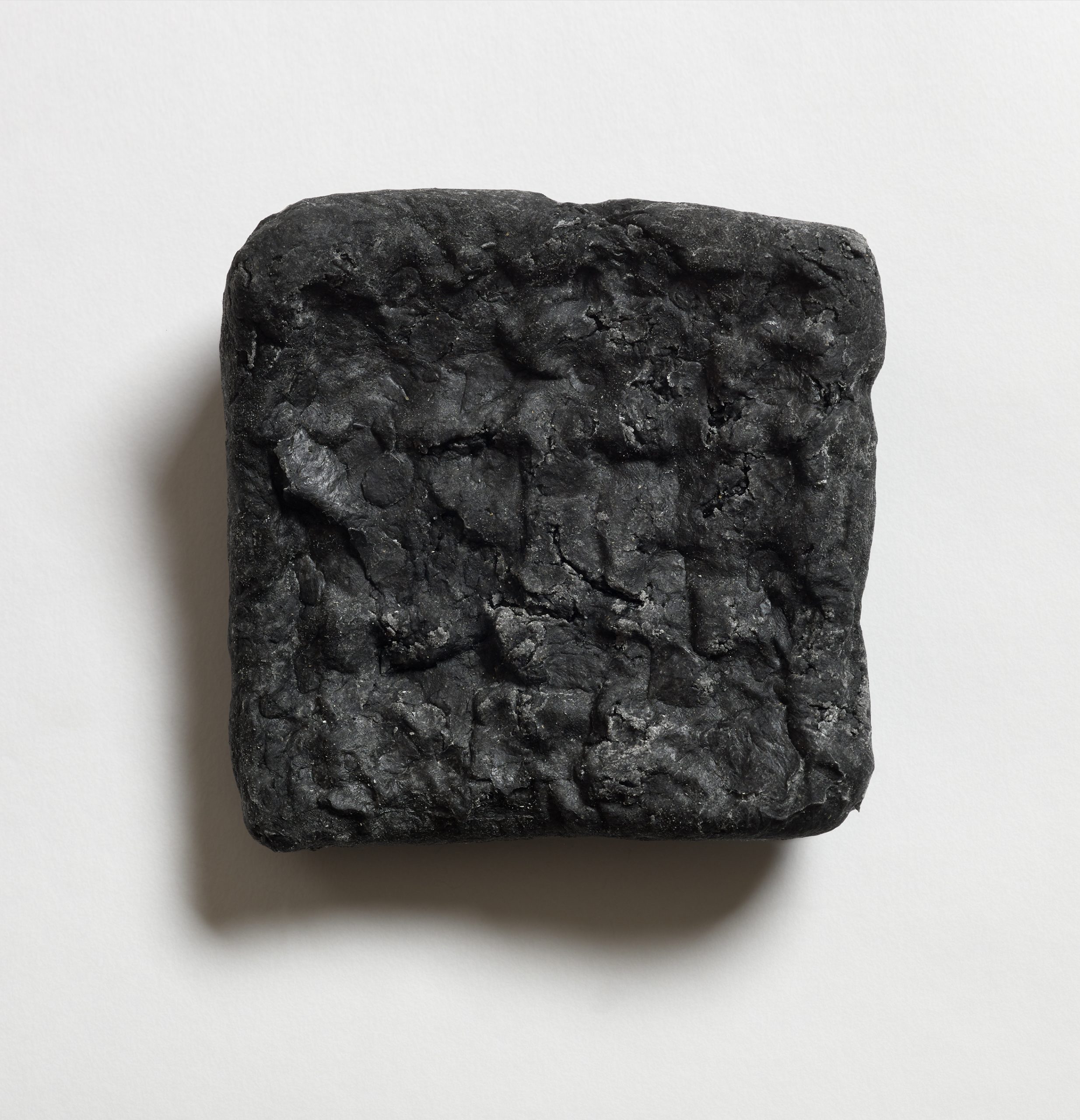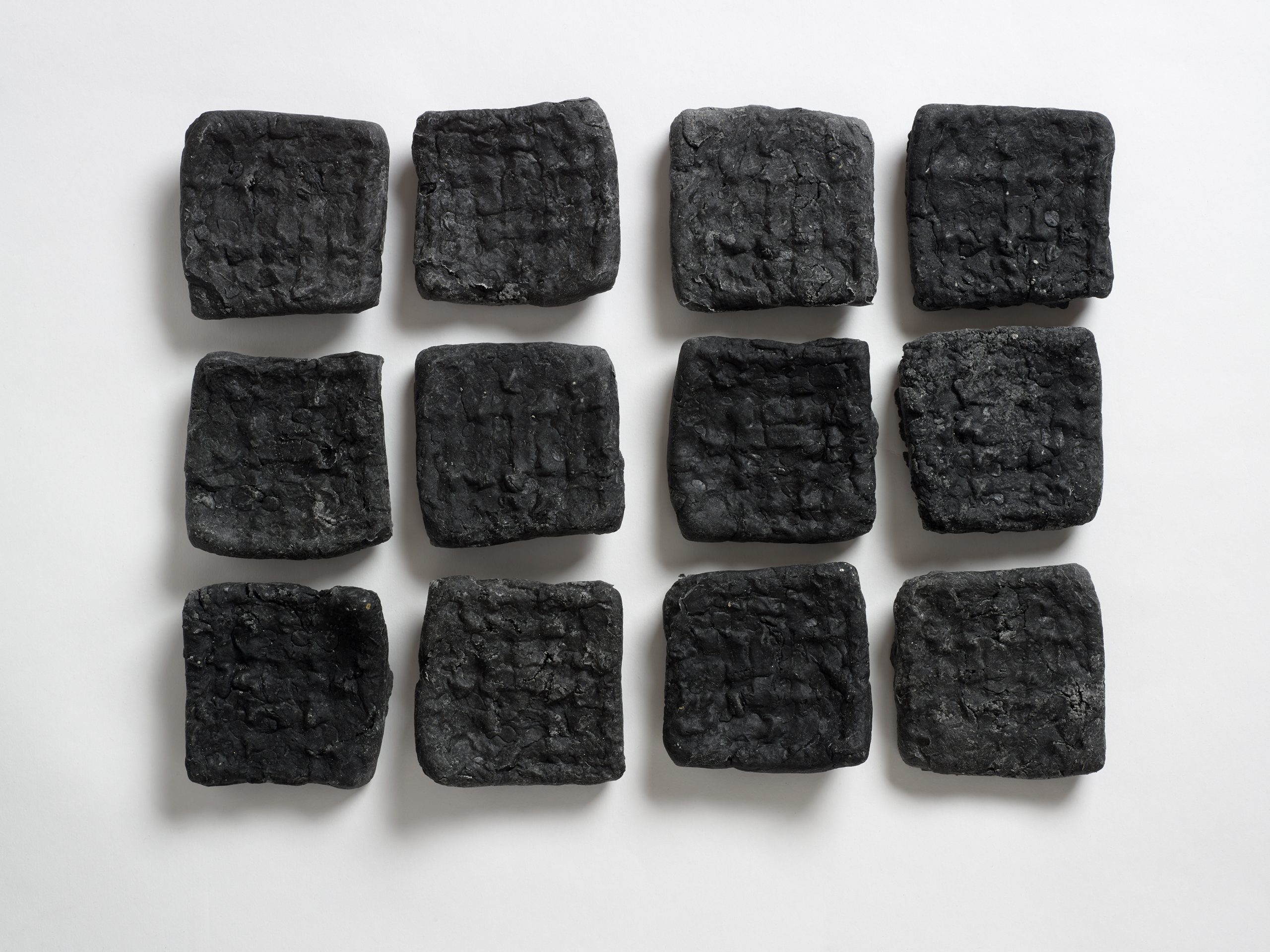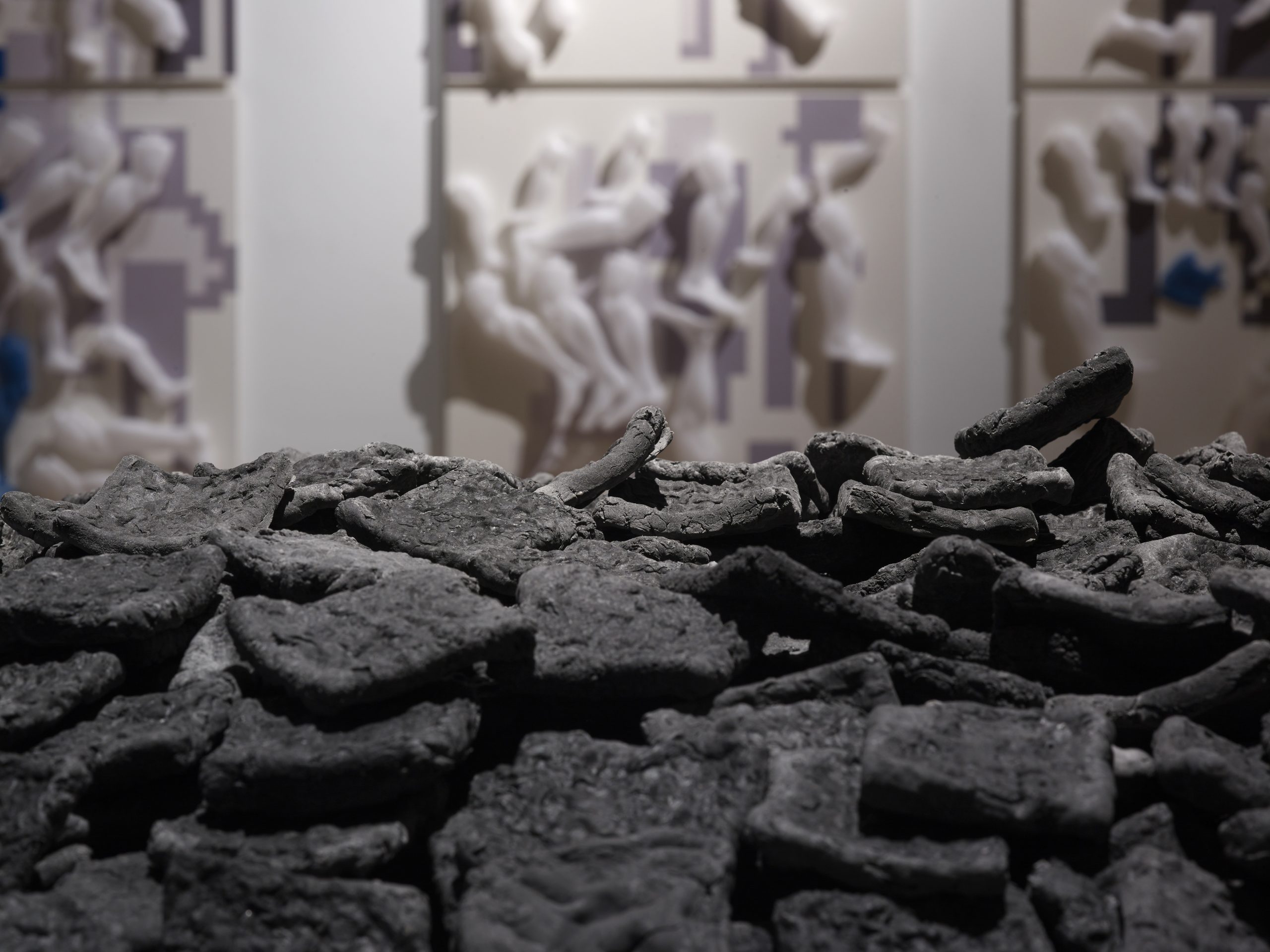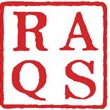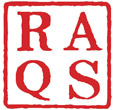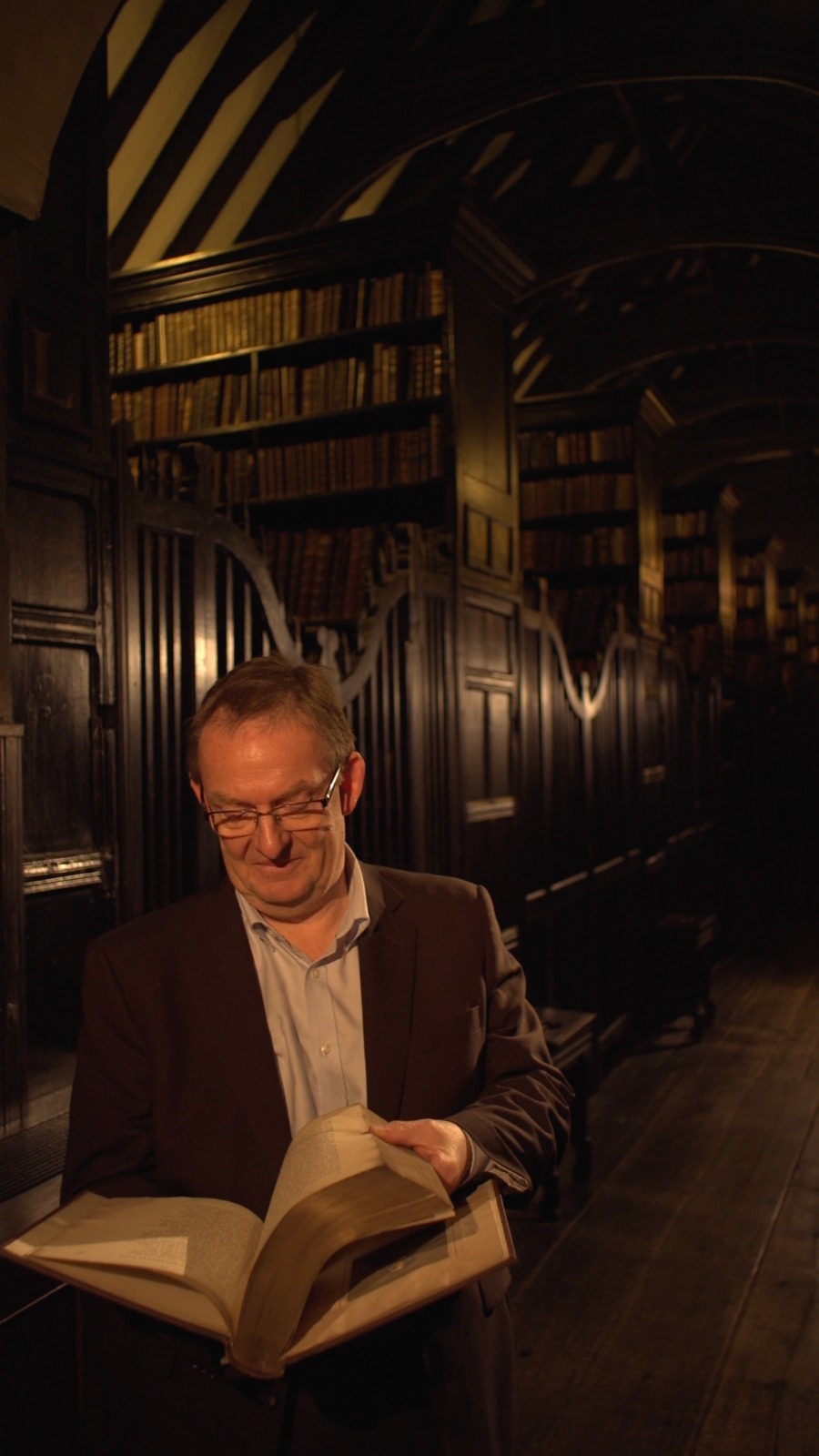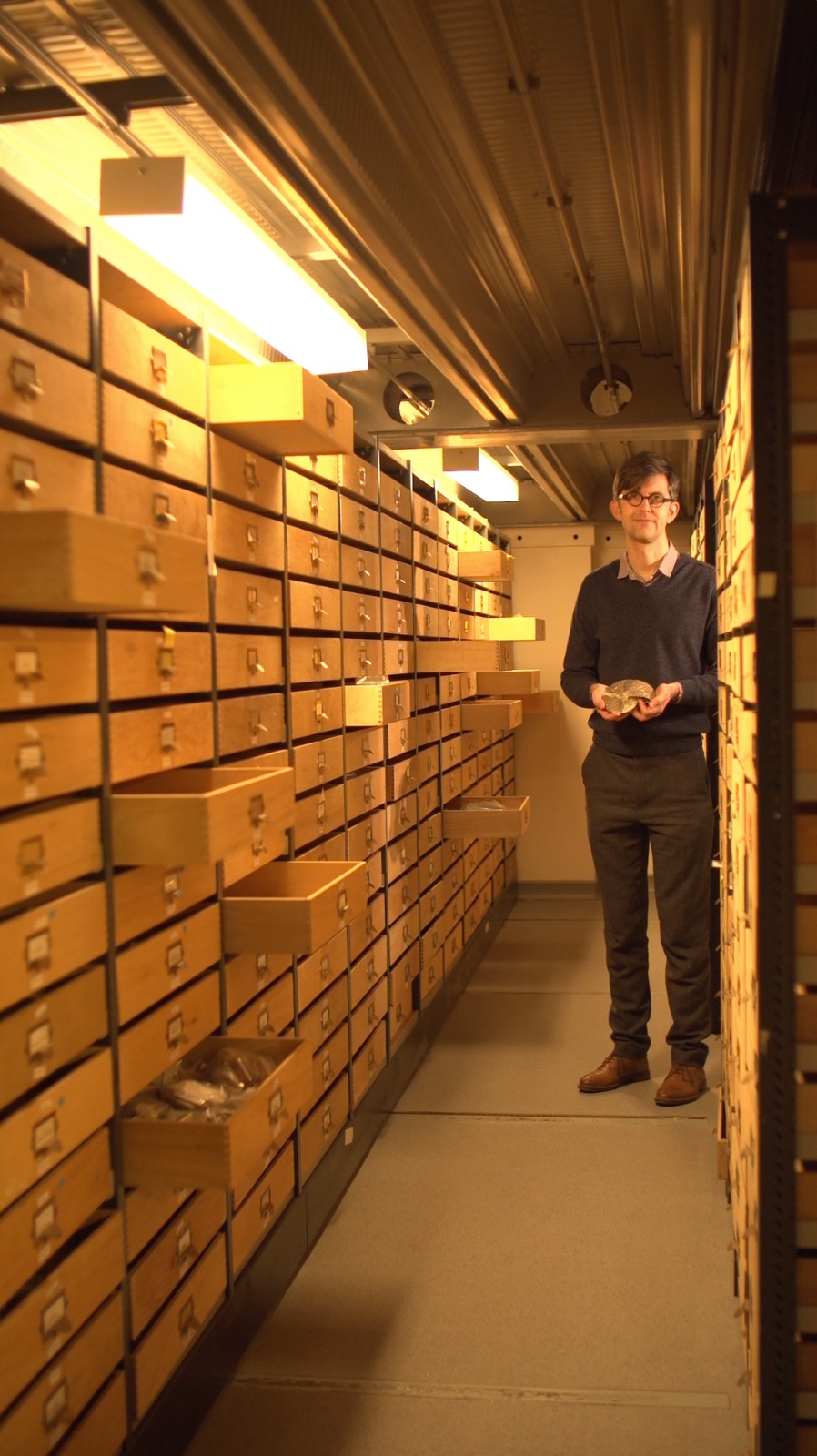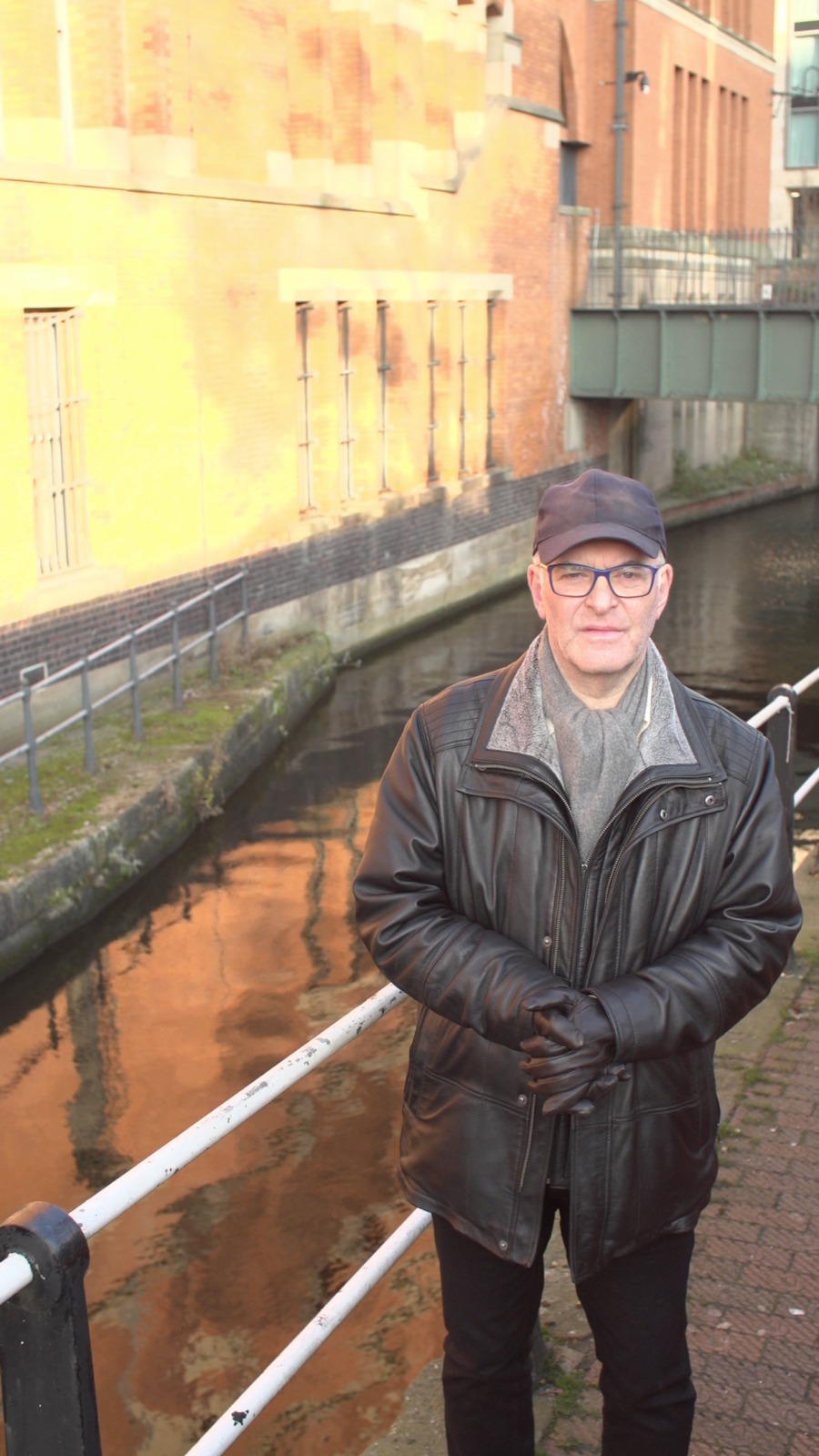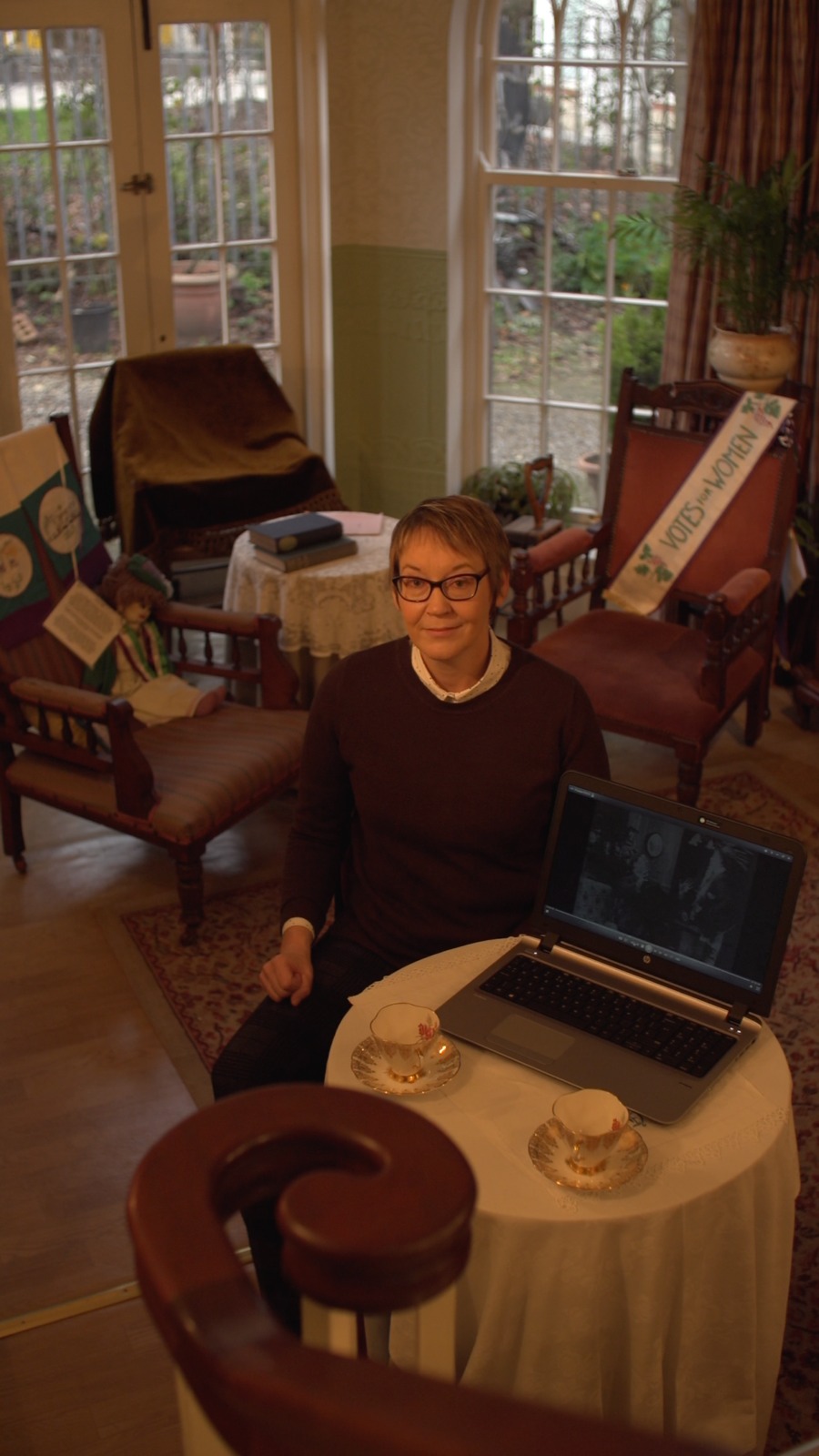
Twilight Language
Solo Exhibition
The Whitworth, Manchester (2017)
Twilight Language is an attitude, pulling from the great weaver-mystic Kabir, that looks at unexpected juxtapositions and untranslatable scenarios.
The exhibition signals a lighthouse semaphore for all that is lost and found between errant longitudes, infected histories and contagious futures. These are the times when everything changes: memorials defect, communards bake biscuits, moths mutate, divers rise, clocks speak in tongues. Animals, machines, and humans recover grounds of equality and conversation. Words turn incandescent, enigma shadows everything, twilight finds its language.
For Twilight Language, Raqs collaborated with scientists, architects, and custodians of Manchester’s histories to make new works that overlap eras in time – of geology, biology and industry – revealing fissures and accumulations, full of future possibilities. These are set within a landscape of earlier works, presenting an exhibition that conveys the breadth of the Raqs’ concerns, and the exhibition connects things together with wit and insight.
A catalogue accompanying the exhibition was also published by The Whitworth
***
Unusually Adrift from the Shoreline
Wood, MDF, light fitting, acrylic sheet, vinyl, silver paint,
4 x 1.3 m
Unusually Adrift From the Shoreline is a work about darkness, light, navigation and memory. The work appears as the top of a to-scale lighthouse, relocated in an interior space, emitting a beam of light that roams and seeks. Its dislocation, and its echo of shorelines and possible danger, are intended to prompt unfamiliar thoughts in the city. Thoughts and feelings about the pleasures and the hidden perils of losing oneself: at sea, and in the oceanic expanse of time.
Iterations at: Neighbourhood Secrets, Stavanger, Norway (2008)
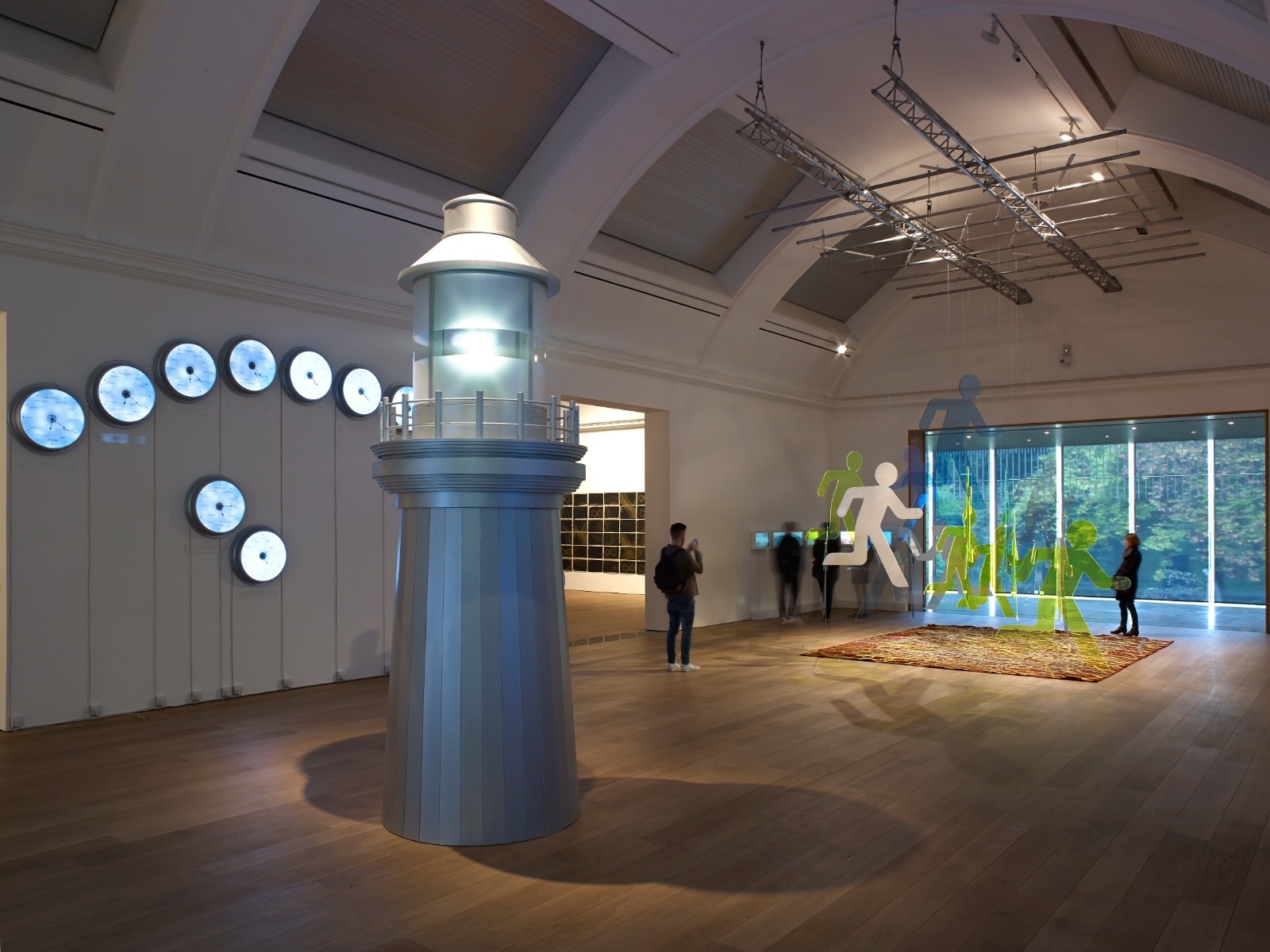
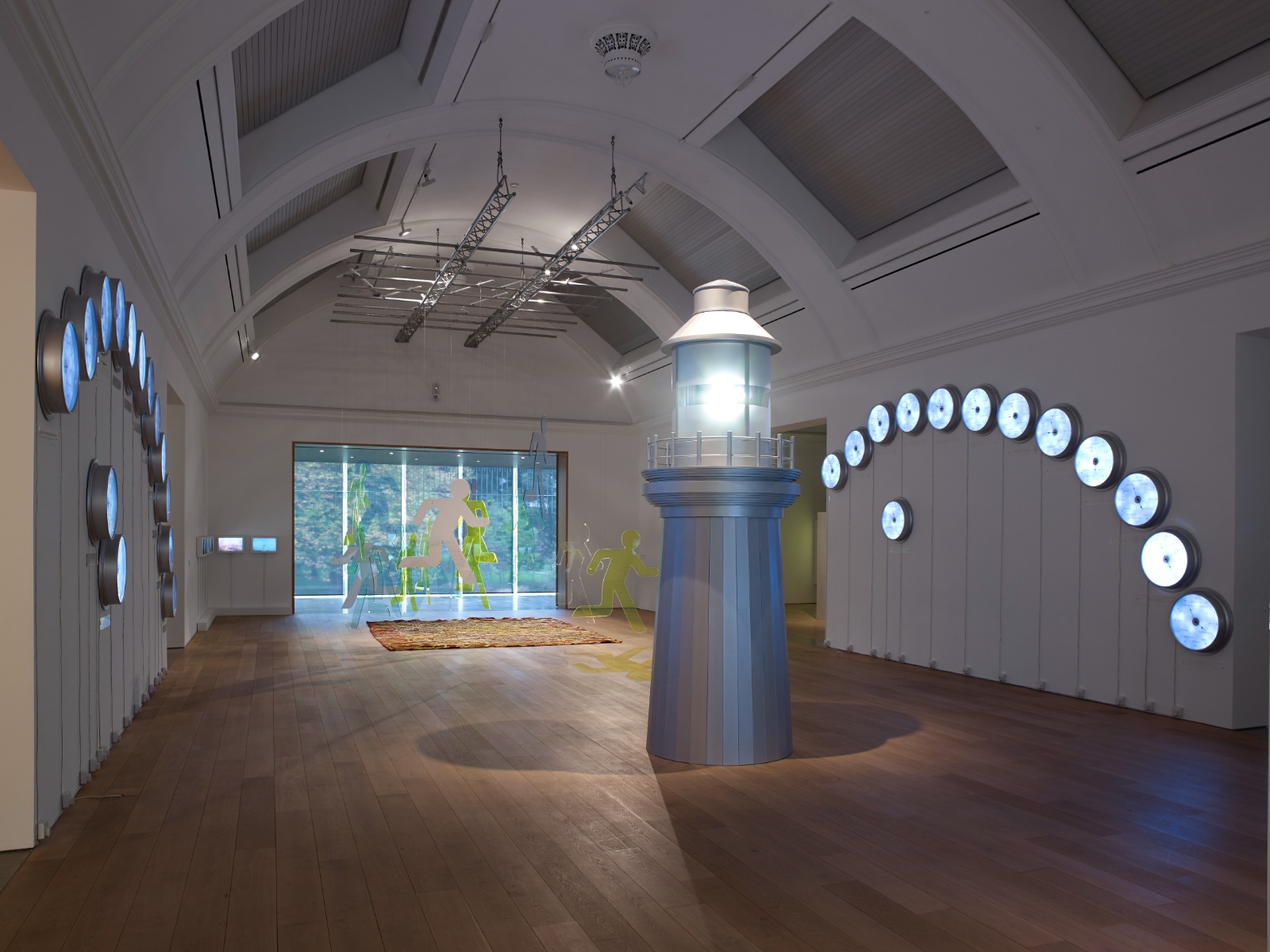
When the Scales Fall from Your Eyes
Mould-blown glass busts, weighing scale, found objects, illumination
Dimensions variable
When the Scales Fall from Your Eyes dismantles our obsessions with measurement and quantifiable evaluation by gathering scales that set out to weigh impossibilities.
An array of glass cast busts are mounted with heads made of top-loading domestic weighing scales. The busts are placed on (or around) a motley collection of domestic objects, or industrial ephemera. These objects, in ghostly white, act as perches or pedestals for the weighing scale-headed glass busts.
Iteration at: IKON Gallery, Birmingham (2009)

27 clocks, high glass aluminium, LED lights
Diameter, each 26 inches
Escapement invokes clockwork, emotions, geography, fantasy and time zones to ask what is contemporaneity – what does it mean to be living in these times, in these quickening hours, these accumulating minutes, these multiplying seconds, here, now?
Escapement is a horological, or clockmaking term. It denotes the mechanism in mechanical watches and clocks that governs the regular motion of the hands through a ‘catch and release’ device that both releases and restrains the levers that move the hands for hours, minutes and seconds. Like the catch and release of the valves of the heart, allowing for the flow of blood between the chambers of the heart which sets up the basic rhythm of life, the escapement of a watch regulates our sense of the flow of time. The continued pulsation of our hearts, and the ticking of a clock, denote our liberty from an eternal present.
With each heartbeat, with each passing second, they mark here and now, promise the future and remember the resonance of a heartbeat that just ended. It is our heart that tells us that we live in time.
Iterations at: Frith Street Gallery, London (2009) |Sao Paulo Biennale (2010) | Deutsch Bank Lounge, Freize, London (2013) | K21, Museum for 21st Century Art, Dusseldorf (2018) | Breguet Pavillion, Frieze New York (2022) | ‘Liminal Gaps’, NMACC, Mumbai (2024) | Serpentine , indian highway
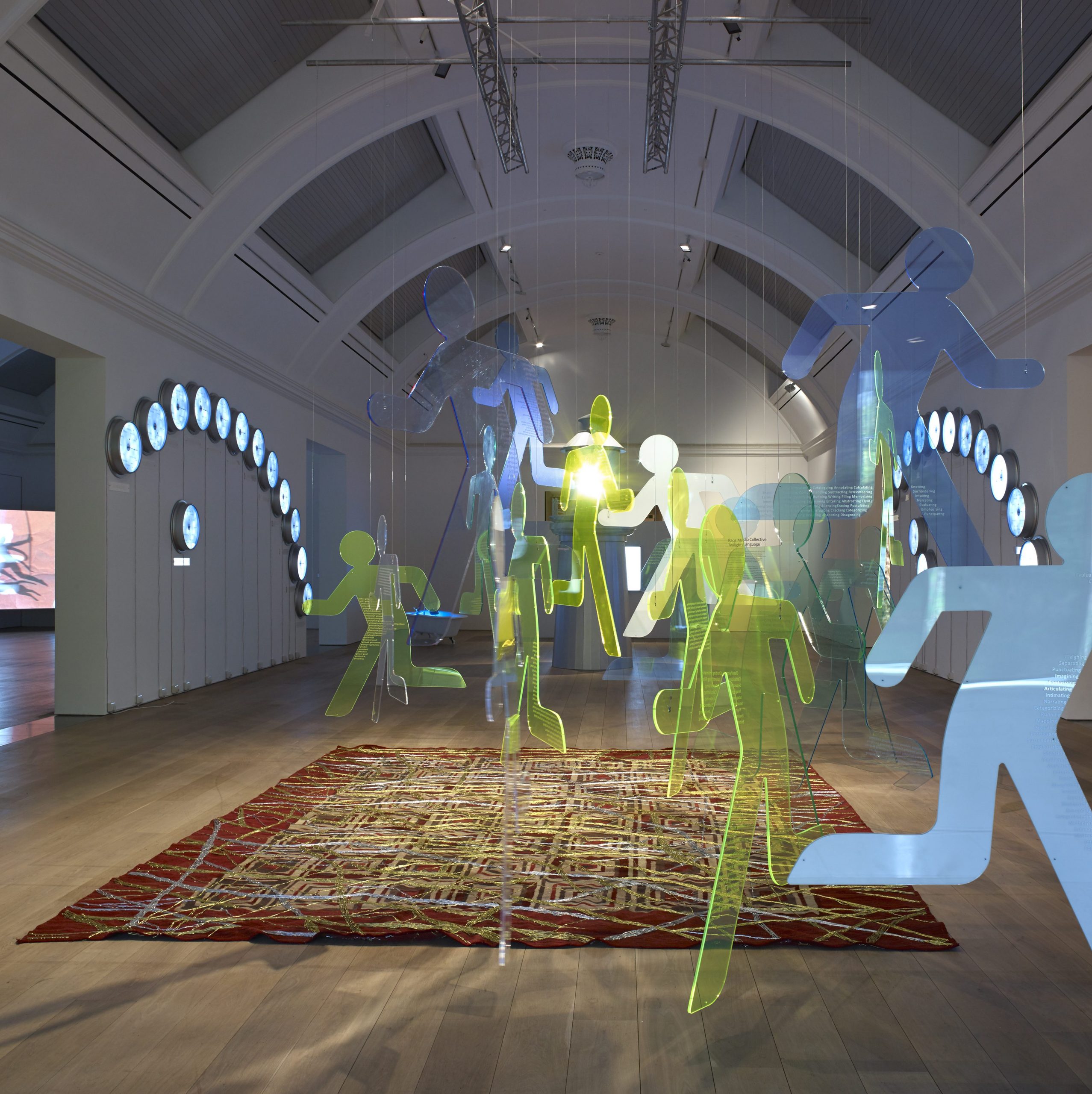
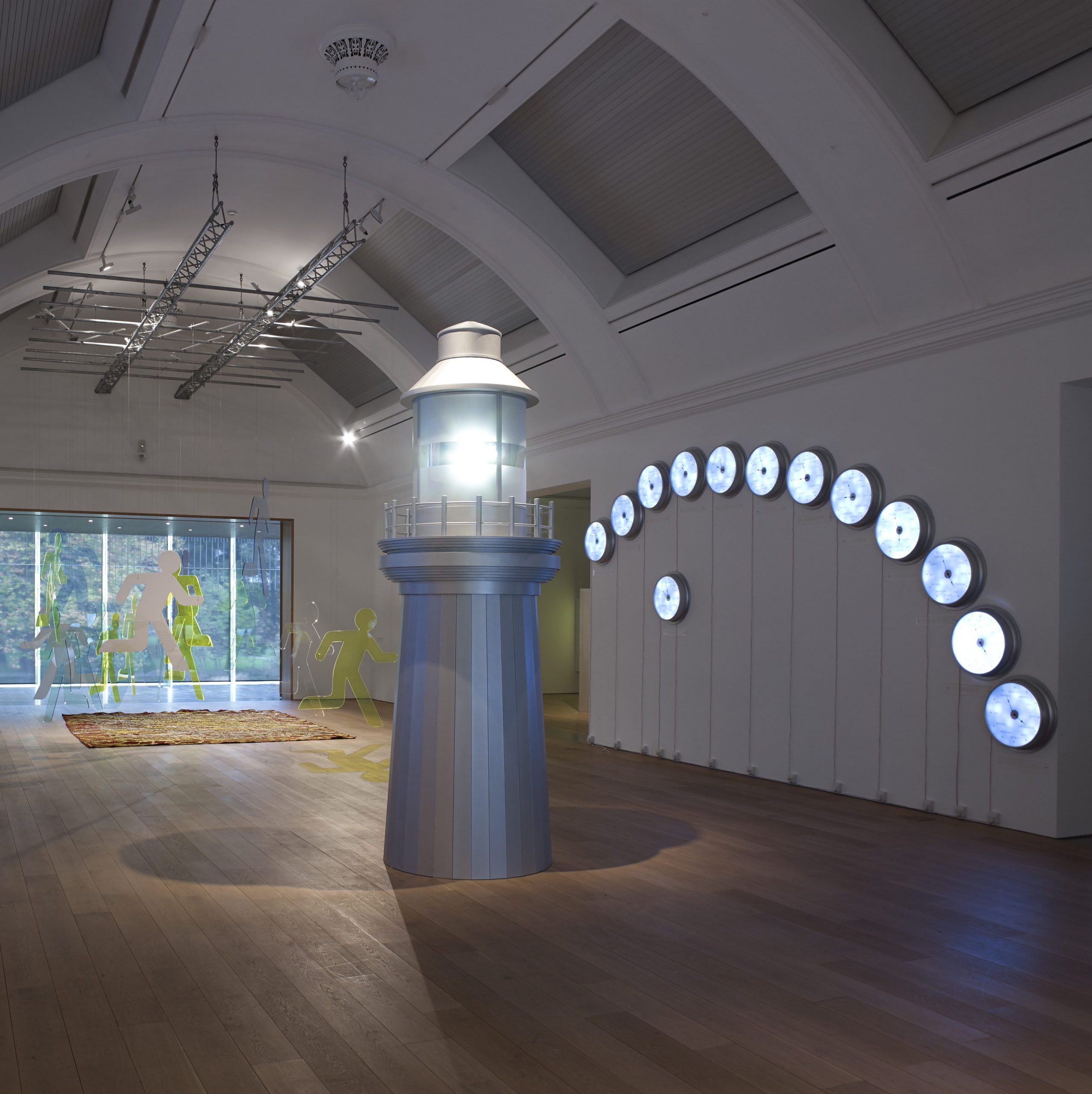
The Things that Happen When Falling in Love
18 coloured and clear acrylic figures with printed mirrored letters, wire cables and fixings
Dimensions variable
The Things That Happen When Falling in Love brings together suggestions of words and people on the move to create an image of a world where the fortunes of both love and labour are framed and dismantled by global forces. Like on-shore sweethearts bidding farewell to men in sailing ships, the world watches its own histories float away. Sometimes, only the words for knowing loss and longing remain.
Iterations at: Baltic Centre for Contemporary Art, Gateshead, Newcastle (2010) | Chronus Art Centre, Shanghai (2013)| NGMA, New Delhi (2014)| K21, Museum for 21st Century Art, Dusseldorf (2018)
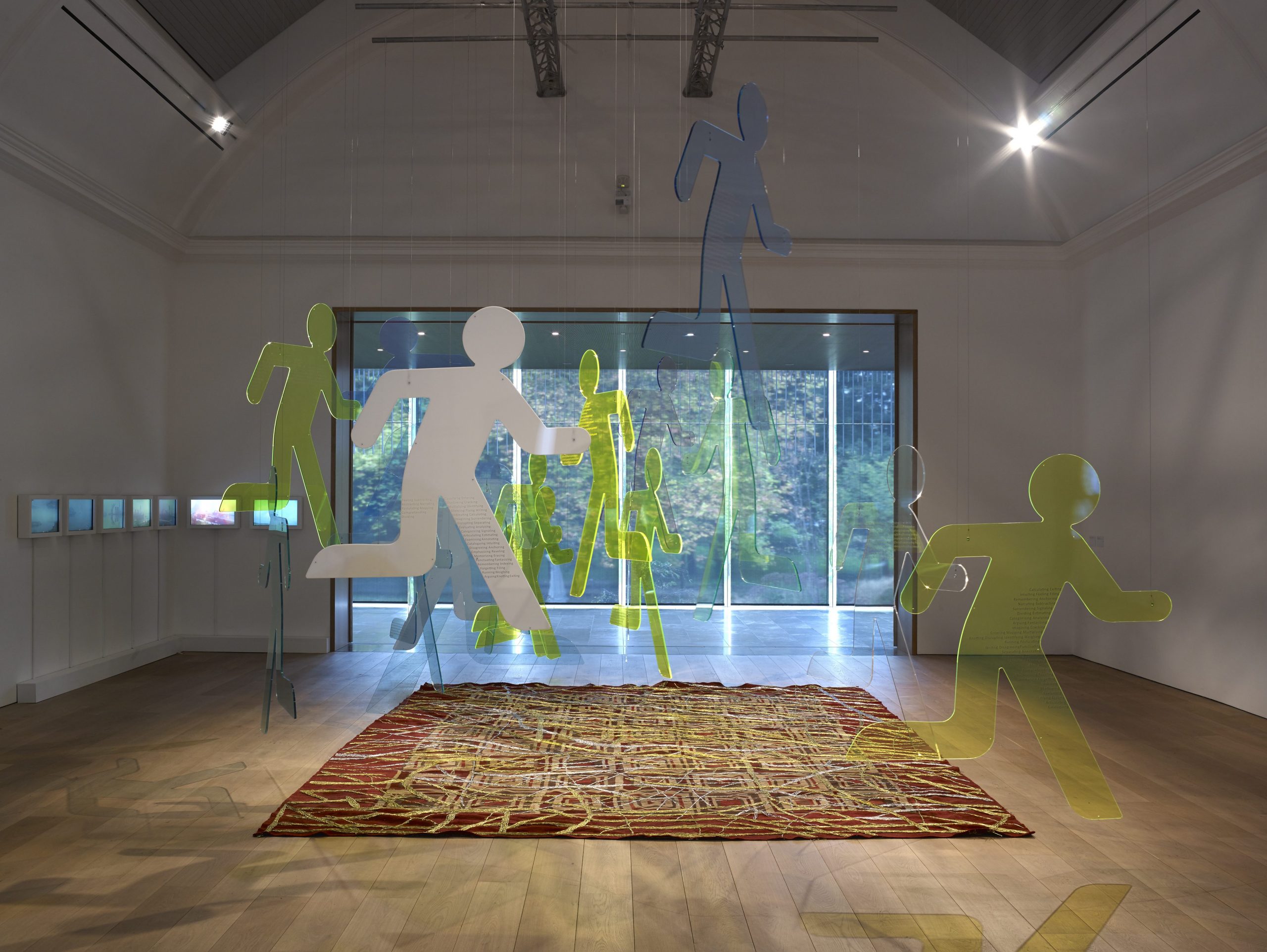
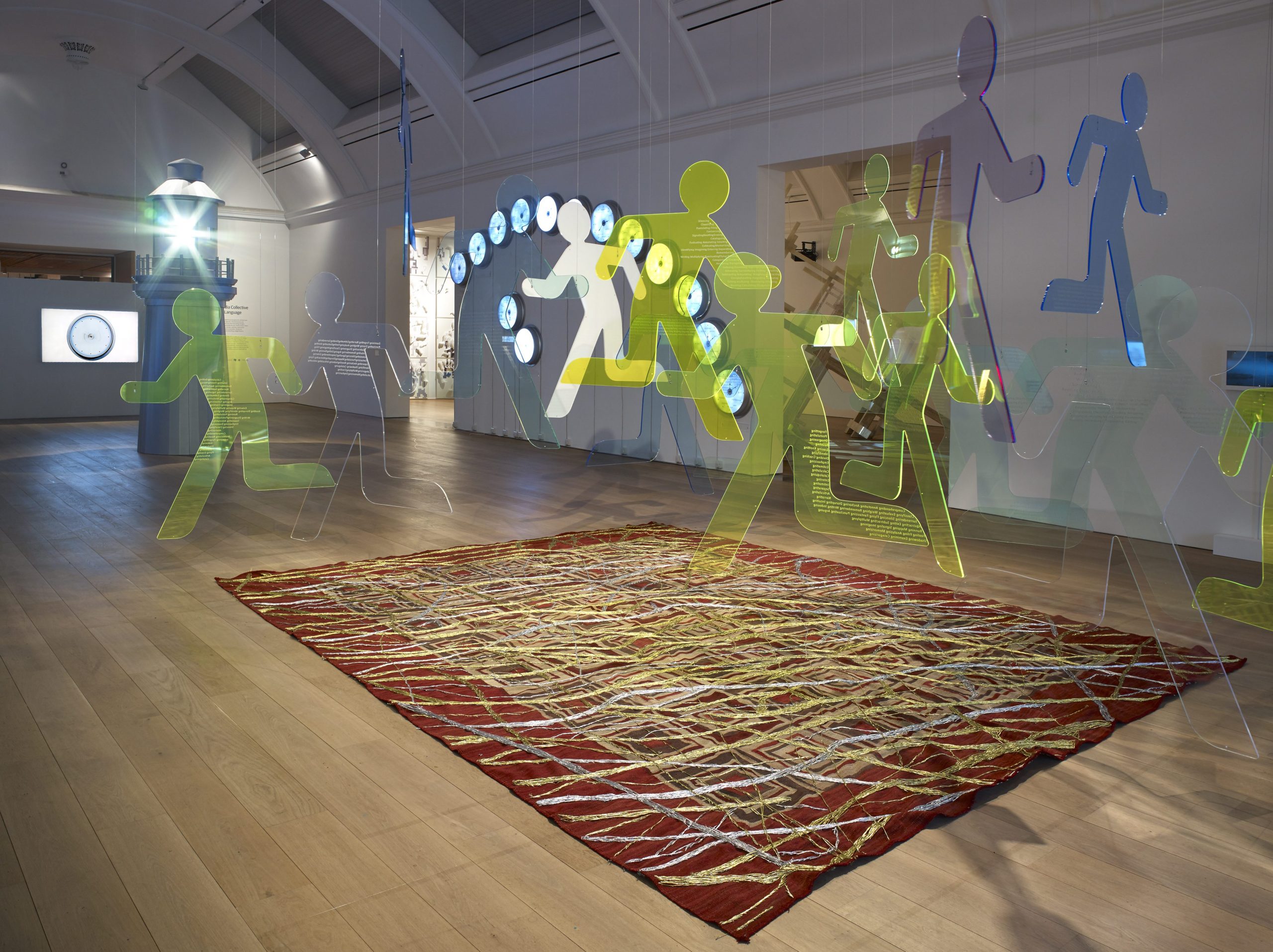
The Knots that Bind are the Knots that Fray
7 screen video installation
Screen 1, 1’24”; Screen 2, 59″; Screen 3, 1’09”; Screen 4, 2’10”; Screen 5, 1’02”; Screen 6, 56″; Screen 7, 1’43”
In early April 2009 the last of the distinctive Titan cranes from the Tyneside Swan Hunter shipyard in northern England were loaded up onto a heavy load vessel and sailed out of the River Tyne. These vast iconic forms were dismantled and shipped to a new life at the Bharati shipyard on the West coast of India.
Raqs took found footage of the last voyage of the ship-building cranes down the Tyne river (shot by an engineer and amateur shipyard enthusiast) to create a world of passages, transitions and departures. The ghostly forms within the images allude to floating worlds, to the enchantment of industrial machinery and the life of ships.They remain indefinite and suggestive of place, evoking an archive built by acts of lay remembering. The video enthusiast’s footage of a piece of local history is transformed in this work into vignettes from a fantastical voyage. The work is both about drifting away and coming ashore. The ‘knots’ of the title can refer both to nautical speed as well as to the complex ties that bind people to histories. Ties hold things together and speed frays them apart. The knots that bind are the knots that fray.
Iterations at: Baltic Centre for Contemporary Art, Gateshead, Newcastle (2010) | Kiran Nadar Museum of Modern and Contemporary Art, Noida, Uttar Pradesh (2012)




9 acrylic frames, video
Dimensions variable, video duration 1″
The picture is a mirage in the desert of now. A thing made of vapour and thirst that hangs over the horizon. A loop caught repeating itself endlessly, like a premonition that is also a memory that is also a warning that is also a moment of reflection. Like a mirror that is also smoke. Empty frames that show you nothing but dèjà vu.
Iterations at: Experimenter Gallery, Kolkata (2011) | Helsinki Photography Biennale, Finland (2014)
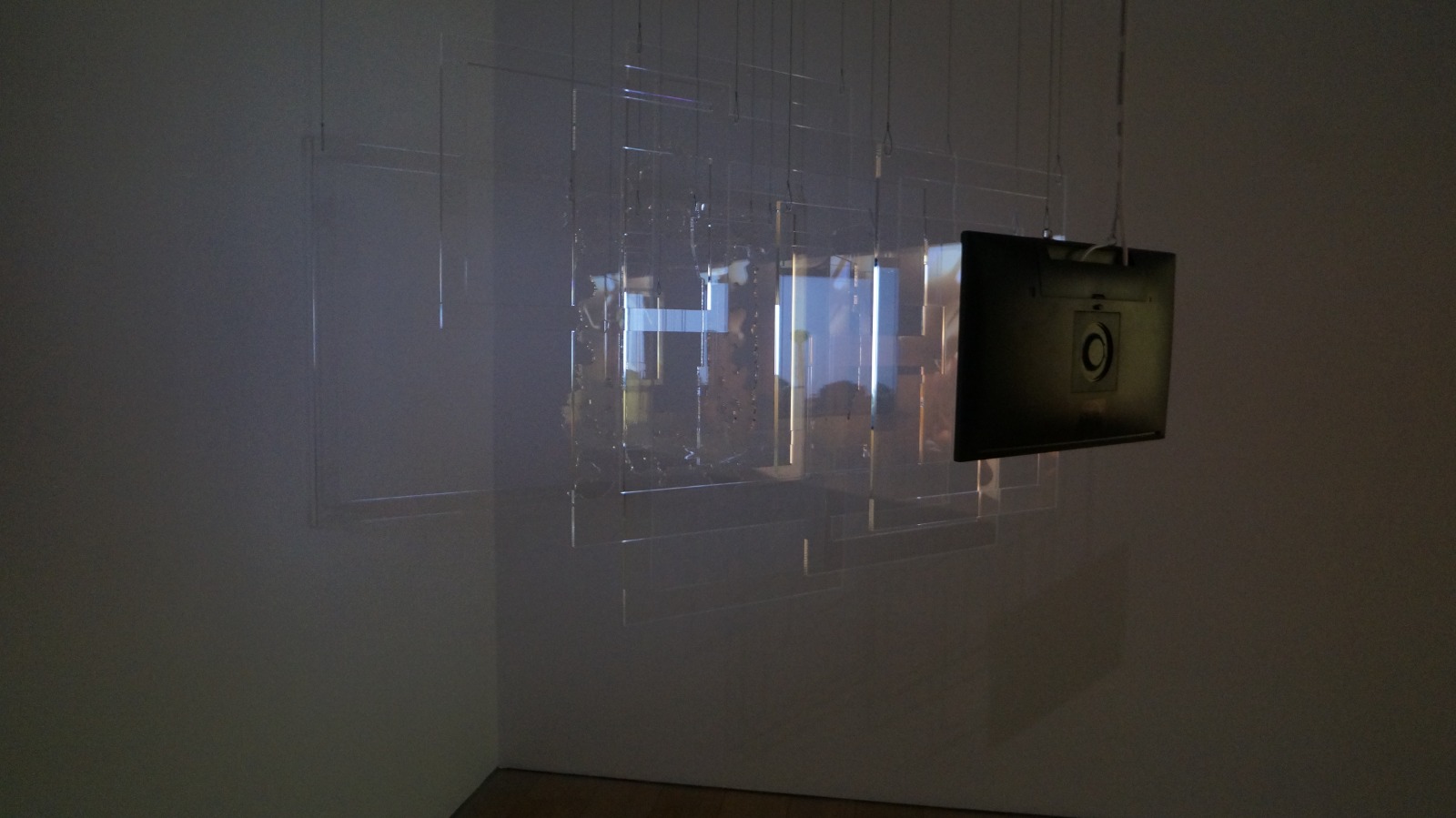
Click here to watch the video (email us on studio@raqsmediacollective.net to request access)
More Salt in Your Tears (2017)
Photograph
Dimensions variable
More Salt In Your Tears first presented as a text sculpture composed of three dimensional stainless steel letter-forms anchored on to a shallow section of seabed of the Baltic Sea near Turku, Finland. The letters combine to form a single phrase – More Salt In Your Tears – that is visible from the decks of passing ferry-boats, ships and low-flying aircraft. The letter-forms are a set of polished surfaces, gleaming like mirrors as they stand one metre above the water and fifteen meters across the surface of the sea. The words change colour as the sea, sky and sunlight vary over the course of the day. The letters act as an index of the alive, changing surface of the sea, the seasons, and of time itself.
The work writes on water, connects the human body through tears to large natural water bodies, and it draws attention to the ways in which we all respond at a subliminal level to the presence of water. This work continues a preoccupation with the emotional resonances of marine and coastal landscapes that began with Unusually Adrift From the Coastline (2008), which had used the memory of abandoned light-houses to tap into the ineffable quality of our encounters with light, horizons and coastlines by the sea.
A photographic iteration of the large sculptural piece was part of Twilight Language.
Iterations at: Contemporary Art Archipelago, Turku, Finland (2011)
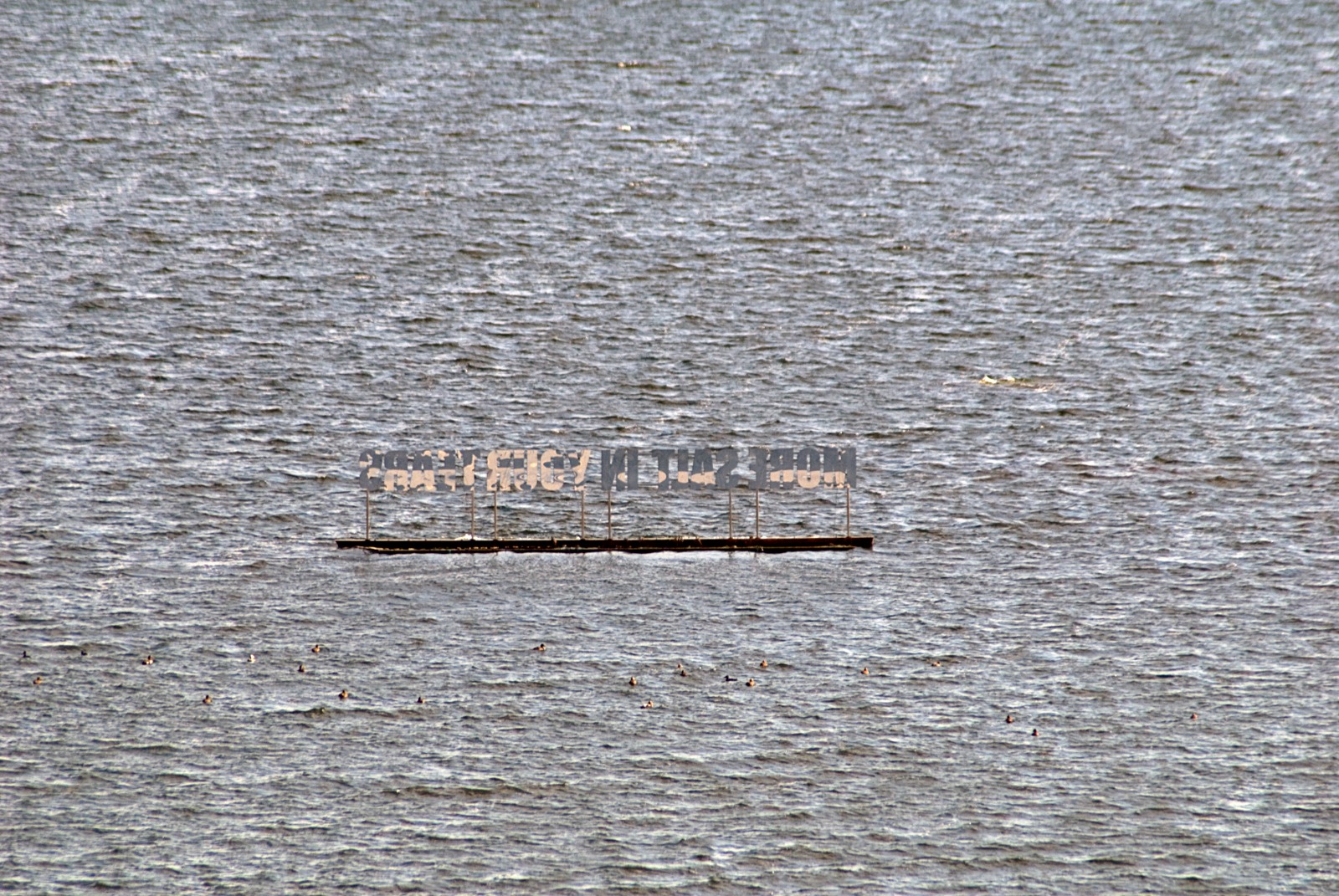
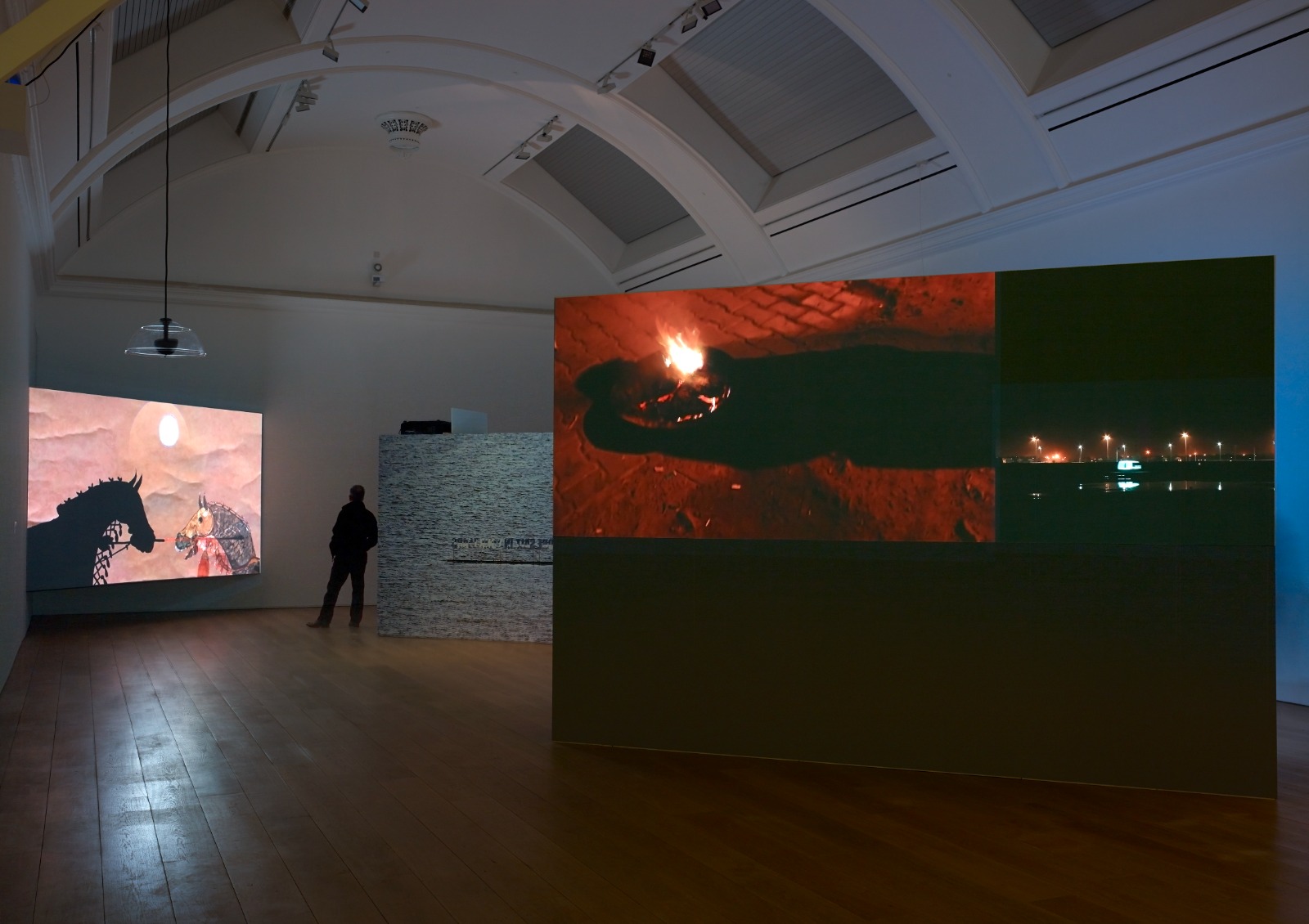
Video, Dipytch
Duration 18’32”
Strikes at Time is a lucid dream. It takes readings from an occasional anonymous journal, and a long walk at the edge of the city of the night, to take back the night.
In that no-man’s land annexed by the awakening mind from the fatigue of the labouring day, the work weaves together a disquisition on time, along with a discreet annotation on the philosopher Jacques Rancière’s ‘The Nights of Labour’, together with renditions of the found text of a worker’s diary by the CyberMohalla Ensemble, a group of unorthodox proletarian urbanists that Raqs has been in dialogue with over a decade.
The shadowy presence of a Yaksha and Yakshi – guardians of wealth in Indic mythologies – stands watching over the work, marking time with questions.
Iteration at: Centre Pompidou, Paris (2011)
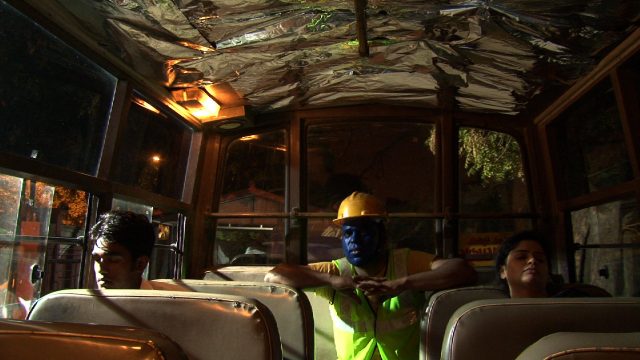
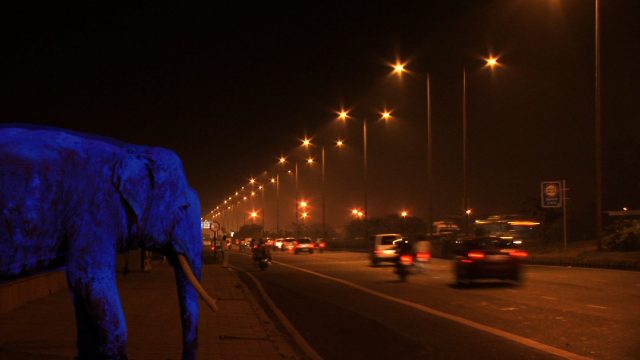
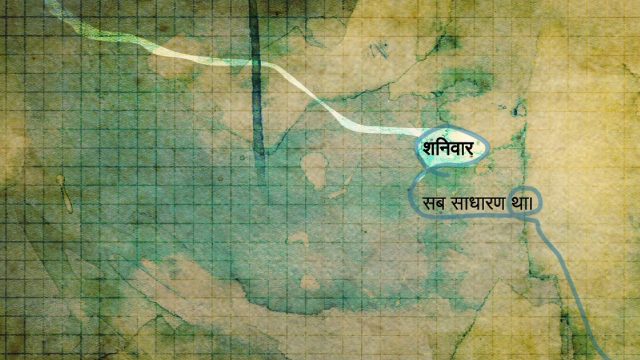
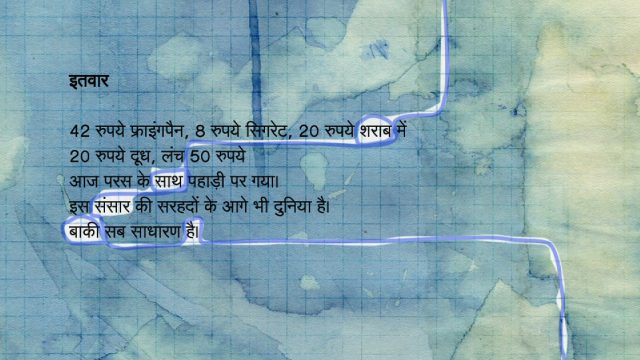
Laser-engraved acrylic glass, furniture, lighting
180 x 150 x 60 cm
36 Planes of Emotions extends the palette of emotions to include states of collective potential. These are embodied in an assemblage of phrases, surfaces, and transparencies that enlist a cluster of invented collective nouns. The nouns etch enigmatic, invented states of being and emotions on to transparent acrylic surfaces. Light, words, perspex hues, and refractions produce their own whimsical annotations.
Iterations at: Art Gallery of York University, Toronto (2011) | The Photographers’ Gallery, London (2012)
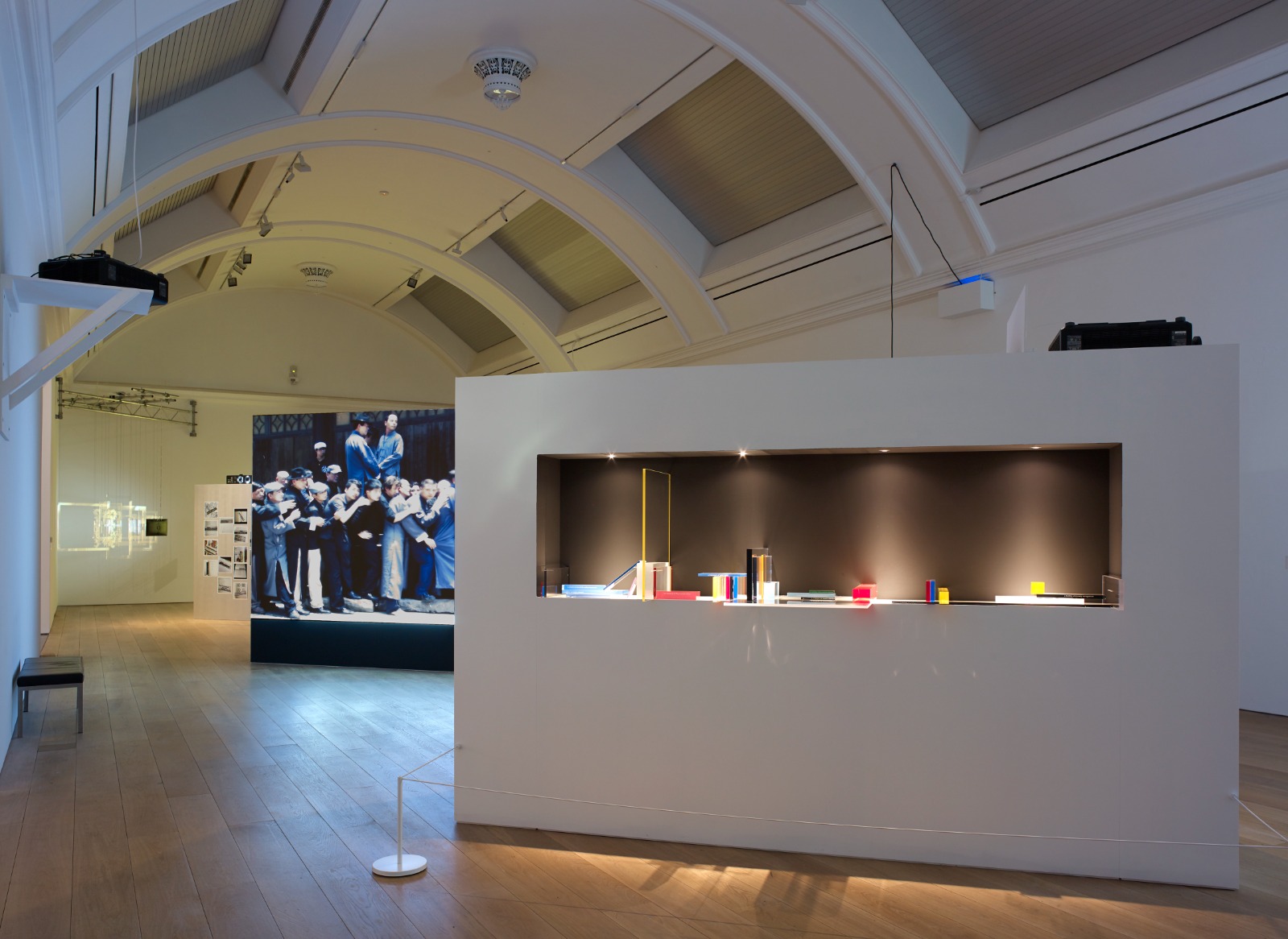
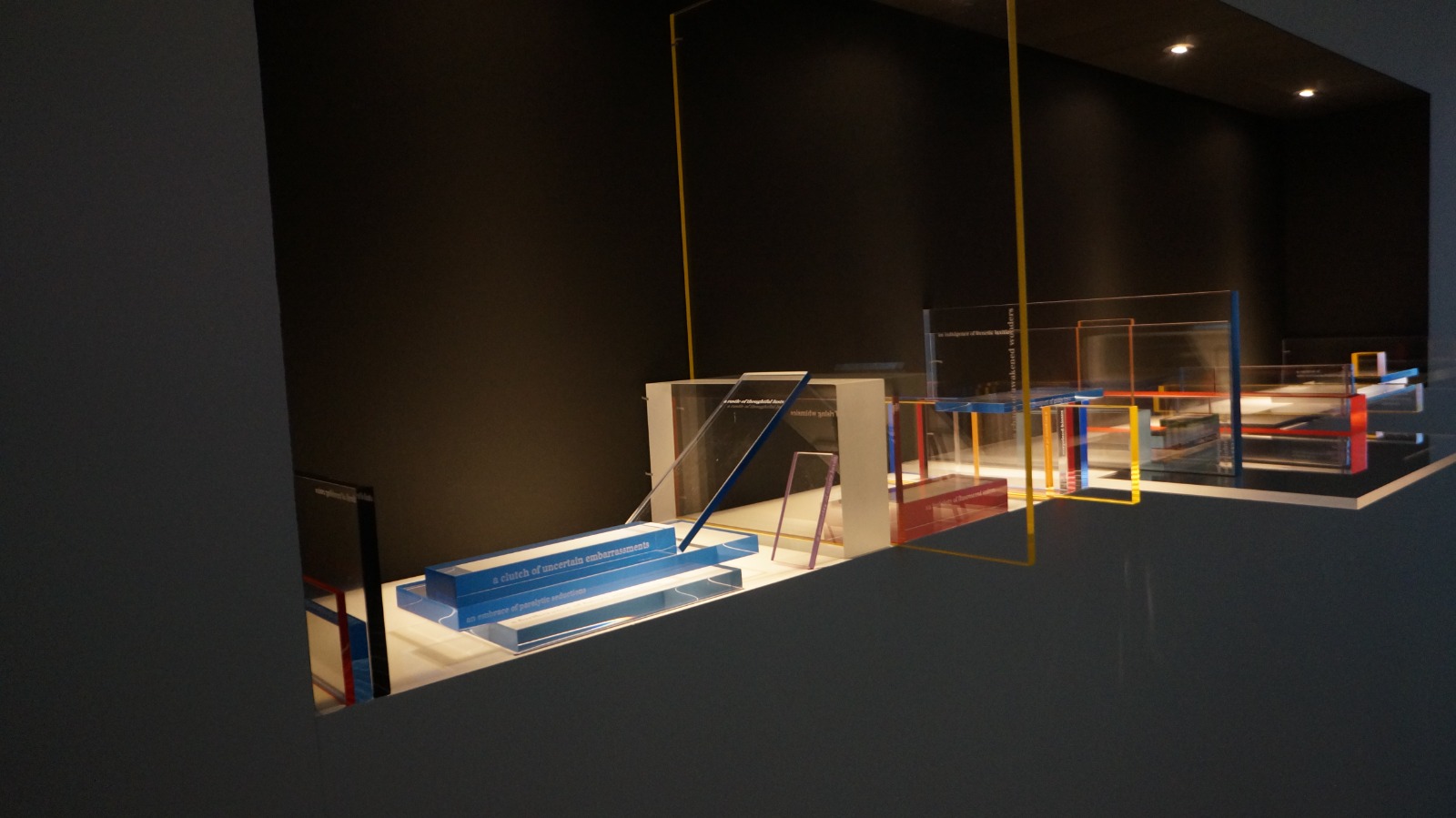
Animated Horological Video, Words
Duration, 4′ 31″
Whenever the Heart Skips a Beat is an animation presenting a clock-face with changing word couplings – instead of numbers – in order to reference the passing of hours. The words are an array of adjectives and nouns that qualify each other, flying across the face of the clock, arranging and rearranging themselves, producing constant permutations and combinations of states of mind and being through the actions of the hour and minute hands that join two words at different points of time.
The lexical patterns produced by this process register a deeply felt, subjective experience of time and duration. This work grows out of Raqs’ sustained preoccupation with time and with the metaphorical possibilities of horology. It annotates their earlier experiment with clocks, feelings and words – Escapement.
Iterations at: NGMA, New Delhi (2014) | K21, Museum for 21st Century Art, Dusseldorf (2018)
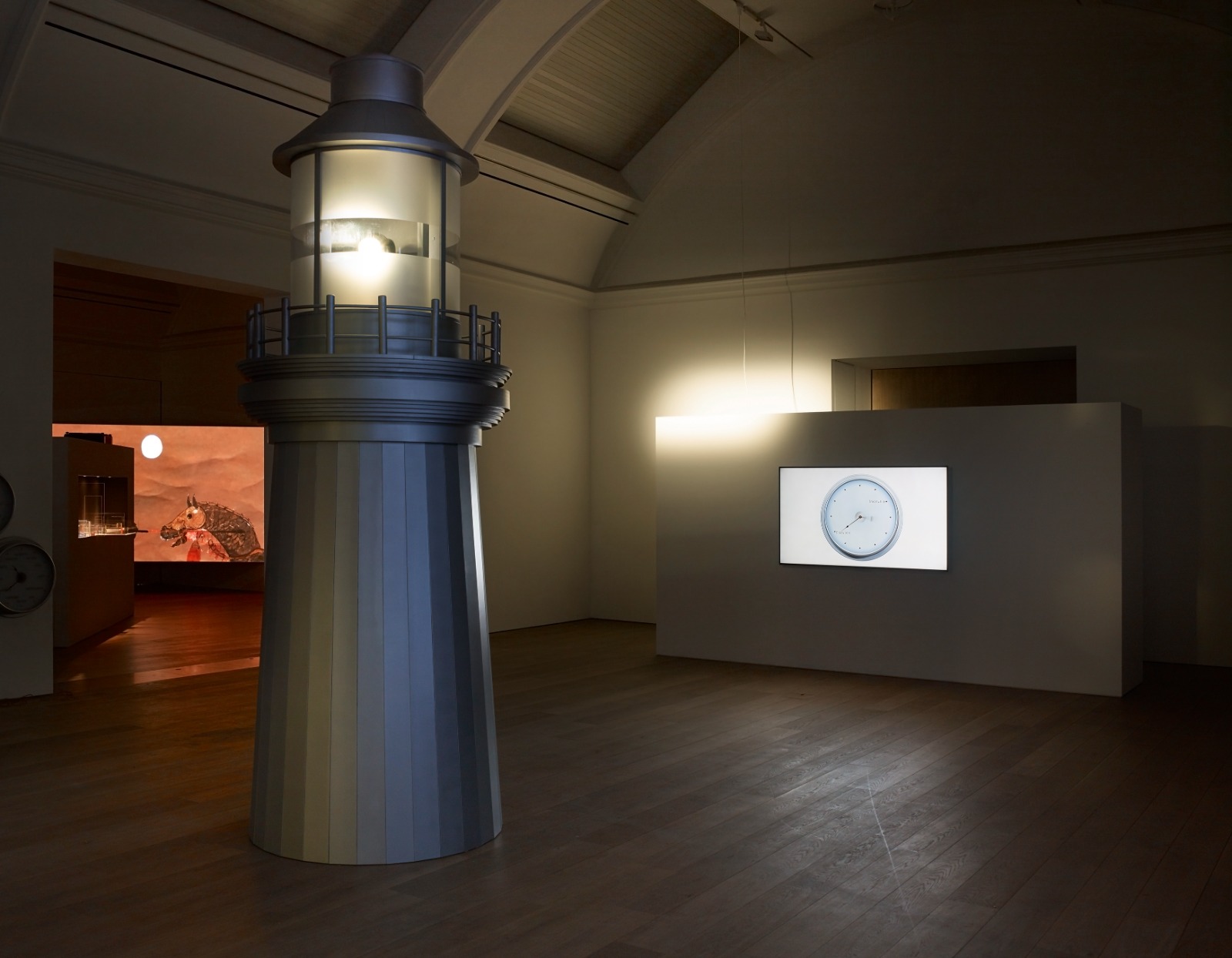
Animation
Duration, 5’25”
A carnival: an autumnal solstice celebration of all that is animate and alive. Horses lose their heads, fish leave their shadows, Diana, the goddess of the hunt is in pursuit of roaring lions and worried dogs and stolid cattle and merry birds and golden dragons.
Equinox is made by Raqs in response to the collection at the Isabella Stewart Gardner Museum, Boston. The video plays on the sense of the night coming alive with animal forms, and echoes their experience during a flashlight midnight tour of the museum where they sensed a different animatedness in the objects of the collection.
Part of ‘The Great Bare Mat & Constellation’, Isabella Stewart Gardner Museum, Boston (2013)| Iteration at: Untimely Calendar, NGMA, New Delhi (2014)
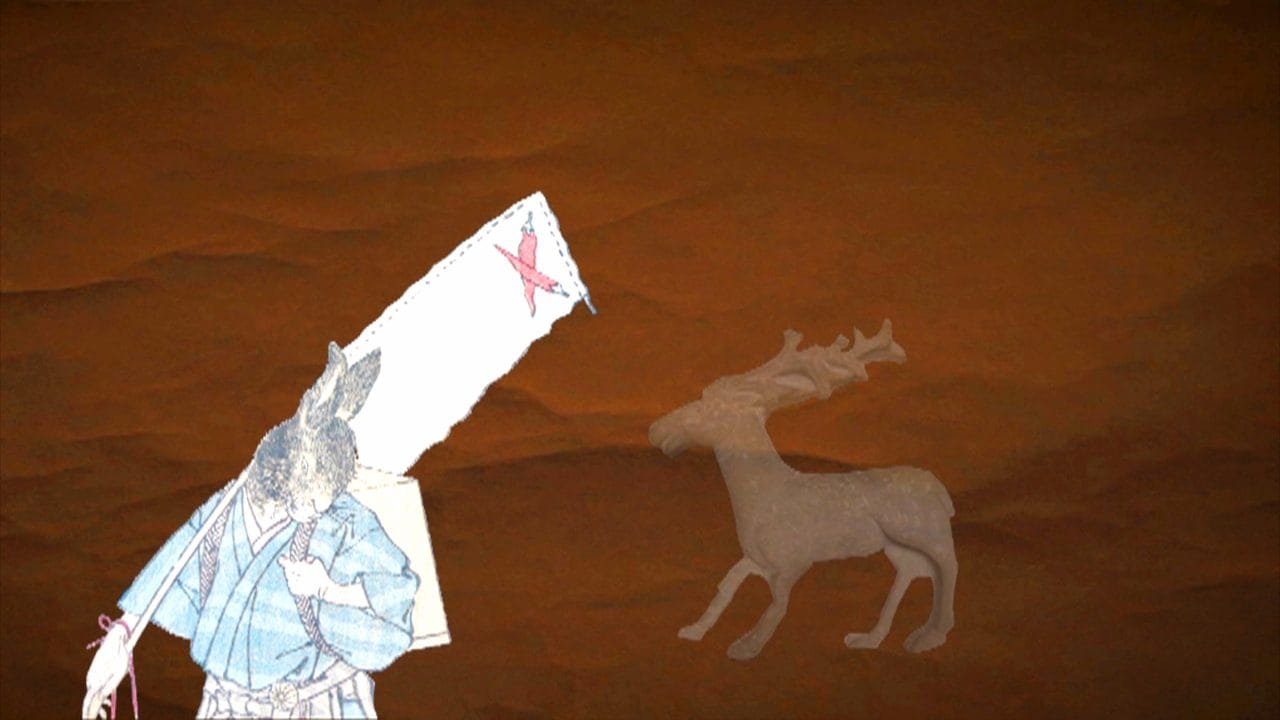
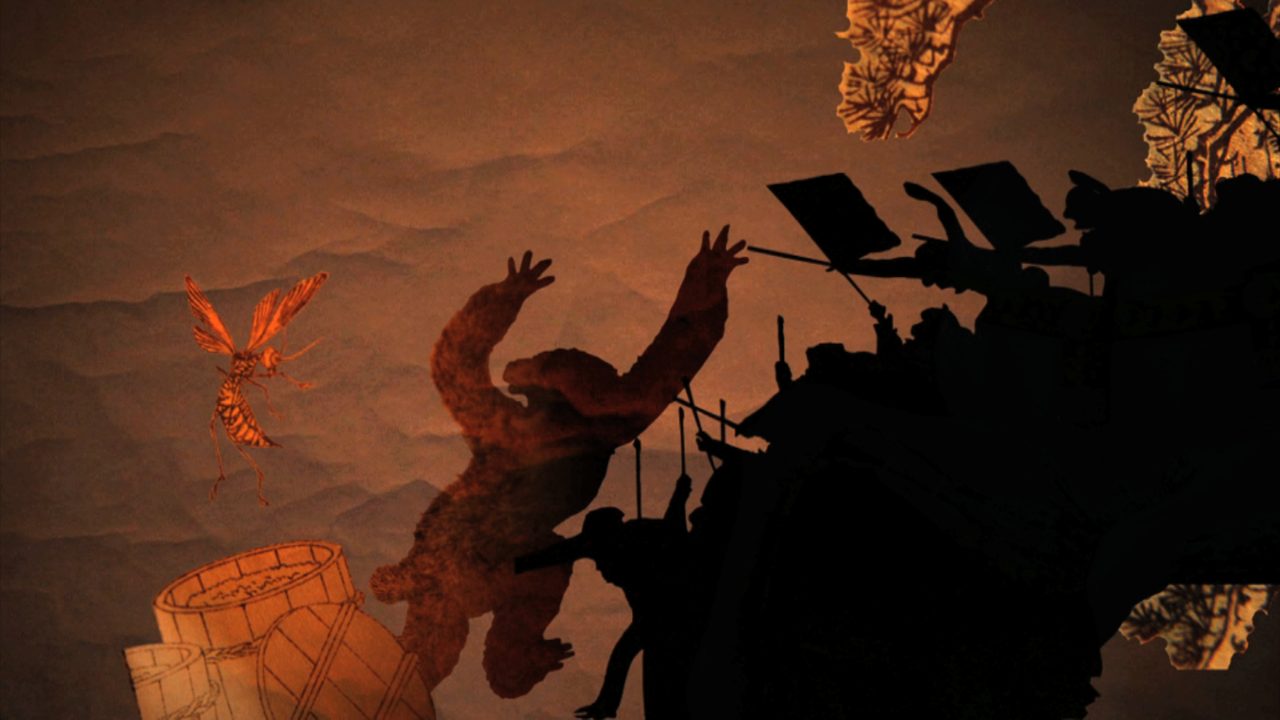
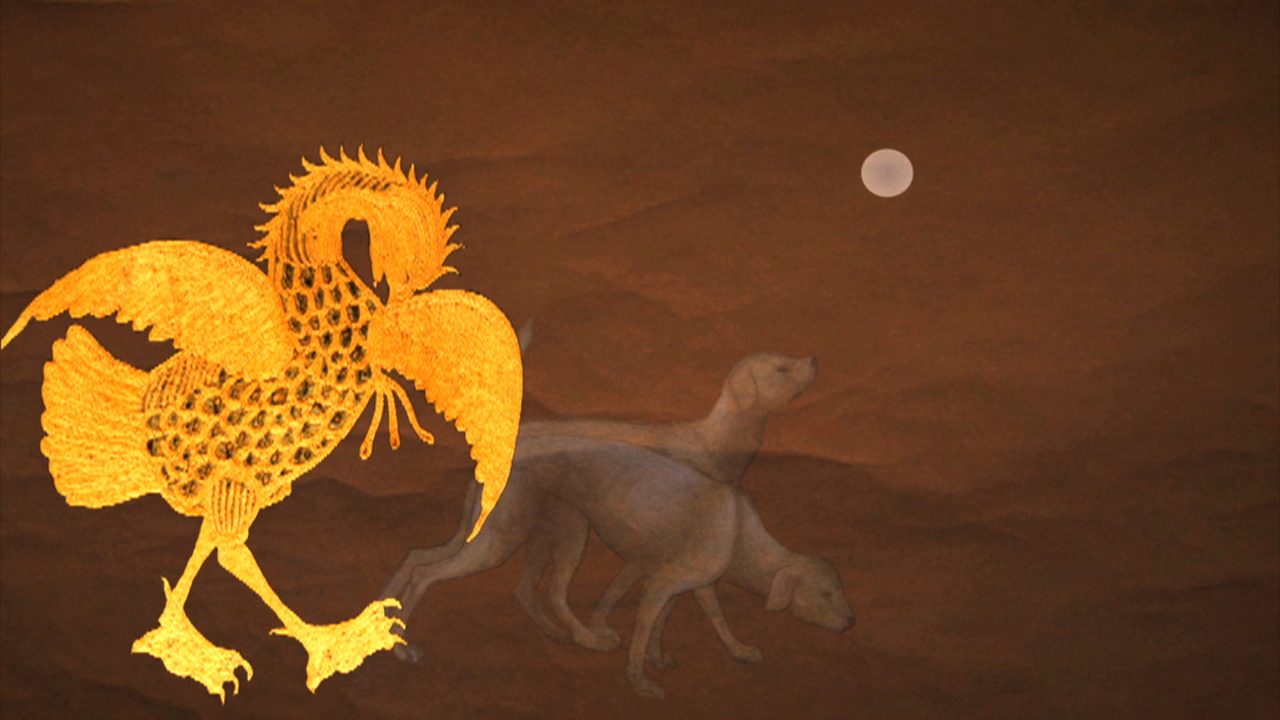
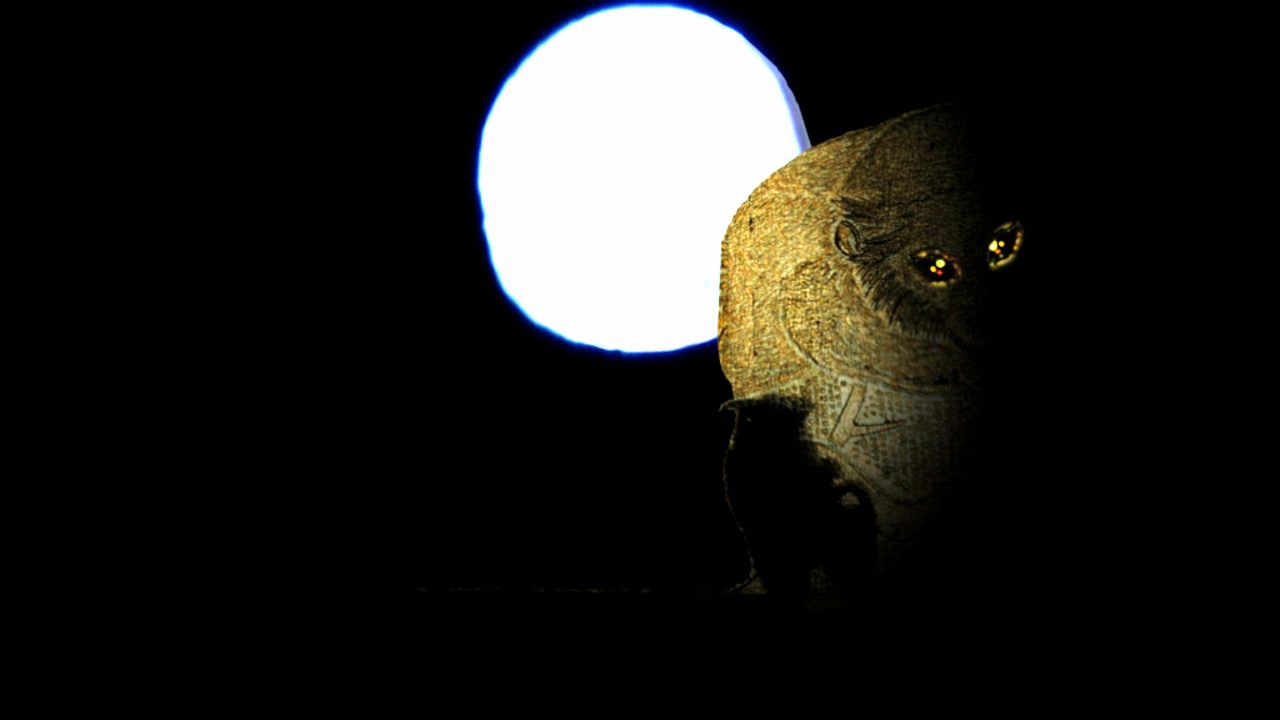
Art in the Age of Collective Intelligence
Photographic prints on metallic paper
36 prints, each 28 x 28 cm
Art in the Age of Collective Intelligence consists of 40 image prints that gloss Raqs’ reading and cultivation of libraries. An iteration of the responses to the question that they had posed to the larger community of St Louis, USA — “If the world was a fair place, then…?”- was rendered as bookmarks, which in their place became the basis for the 40 entries that constitute this work. Layered texts within the images and books examine the ideas of ‘fairness’ and ‘unfairness’, using cut-out fragments of passages as shadowed insertions, leaving both physical and contextual marks. These were produced as photographic prints, which were then inserted into the open pages of books in the personal libraries of Raqs. In this way the work became a bearer of two levels of reading a symptom in the world. A ‘reading’ of what people think of as fairness of justice, and then using that ‘reading’ to annotate further levels of reading – within the expanding ambit of curiosity that constitutes their continuing process of reading and thinking. What this focuses on is the way in which ‘reading’ practices in Raqs are also a way of eavesdropping and whispering, of note taking and re-reading, or parsing a collective intelligence which touches us all, and which we all contribute to.
Iteration at: Adam Aronson Gallery, Laumier Sculpture Park, St. Louis. Missouri (2015)
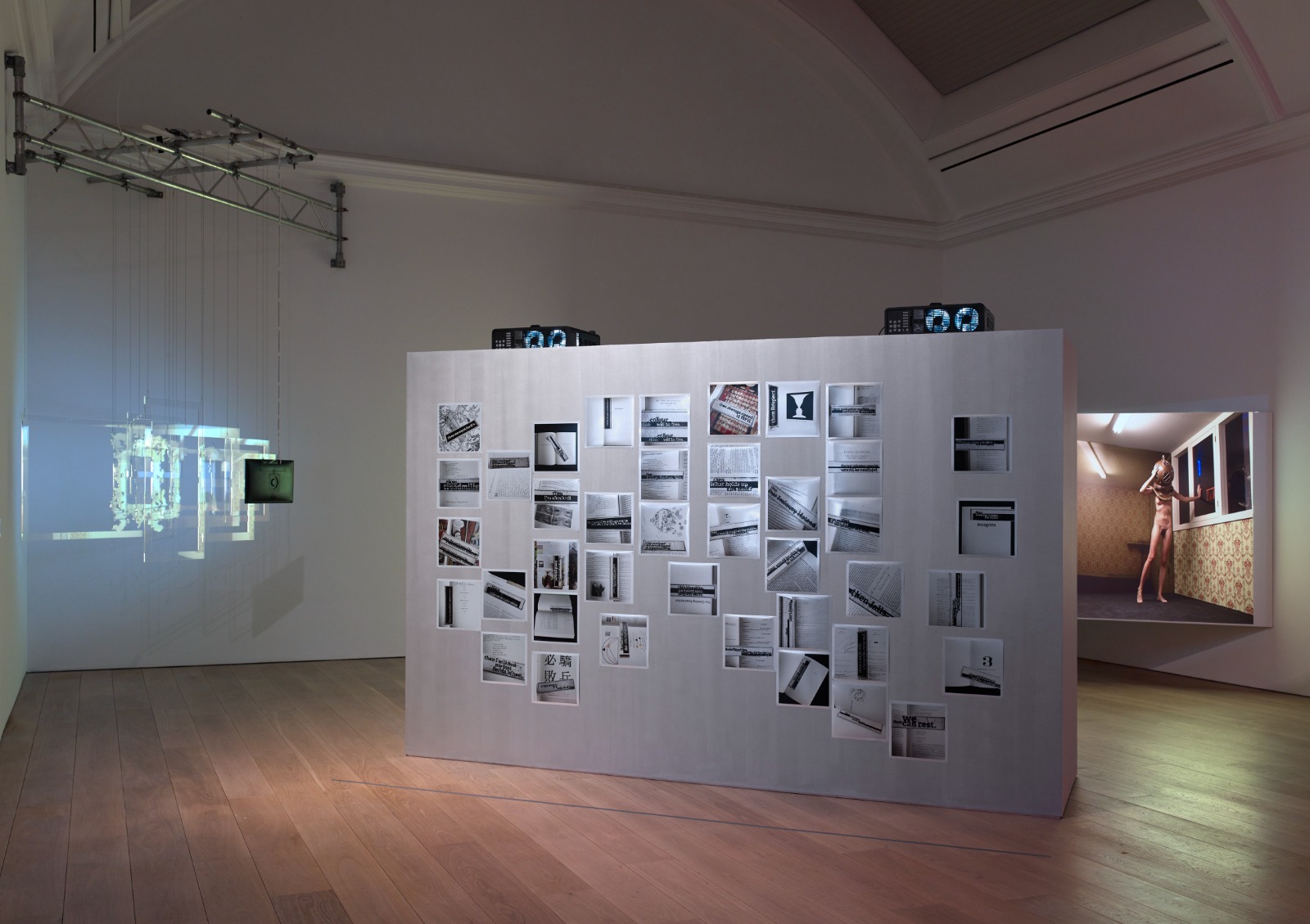
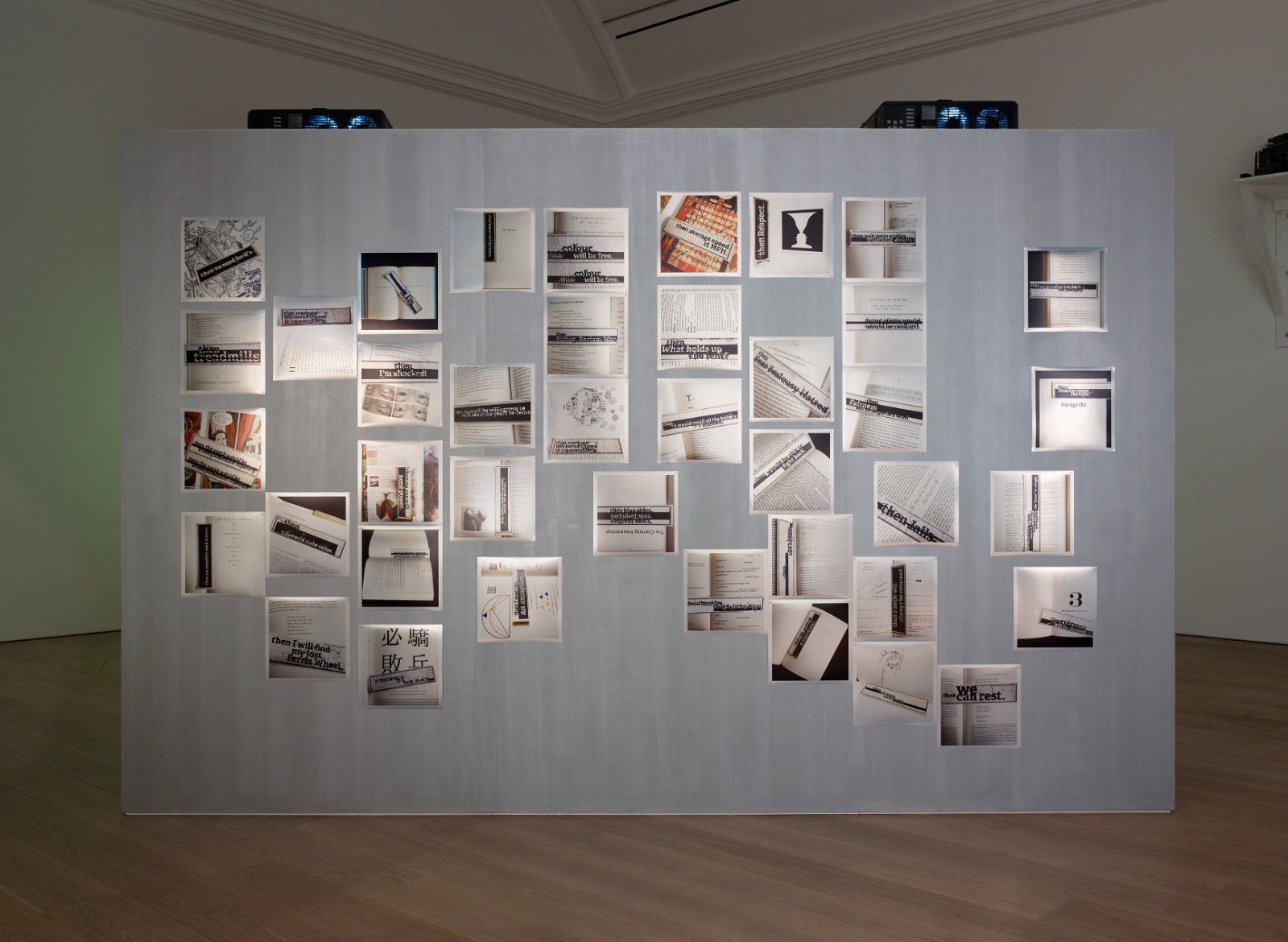
Eight sculptures (resin), nine plinths (wood and bitumen) and nine plaques (faux black marble)
(4 sculptures displayed)
Disfigured, 27 x 0.84 x 1.07m; Truncated, 1.8 x 1.16 x 0.77m; Empty Robe 2.6 x 1.15 x 0.93m; Bending Man, 2.5 x 1.05 x 1.03m
Coronation Park offers nine meditations on power’s deepest anxiety: the inevitability of abdication, which always shadows its claim to permanence.
These formations, presented as defaced, truncated and interrupted sculptures – are reminiscent of, or abstracted from, erstwhile Imperial statuary.
In this case, they also reference an actual site of some dereliction and neglect called Coronation Park, located at the outskirts of Delhi, where the Imperial Durban of 1911 was held to pay homage to the British Monarch and his consort when they visited the citadel of their Indian Empire. Today this site is the last refuge of abandoned and dethroned statues of monarchs and viceroys that once graced places of prominence in India’s capital.
In Coronation Park, Raqs makes nine quasi-doppelgängers of these Imperial residues stand on, beside, and in one instance, go AWOL from, their plinths.
For this exhibition, 4 sculptures were displayed, namely ‘Disgfigured’; ‘Truncated’; ‘Empty Robe’ ; and ‘Bending Man’ (that then joined the permanent collection of The Whitworth).
Iterations at: Giardini, Venice Biennale (2015) | K21, Museum for 21st Century Art, Dusseldorf (2018)
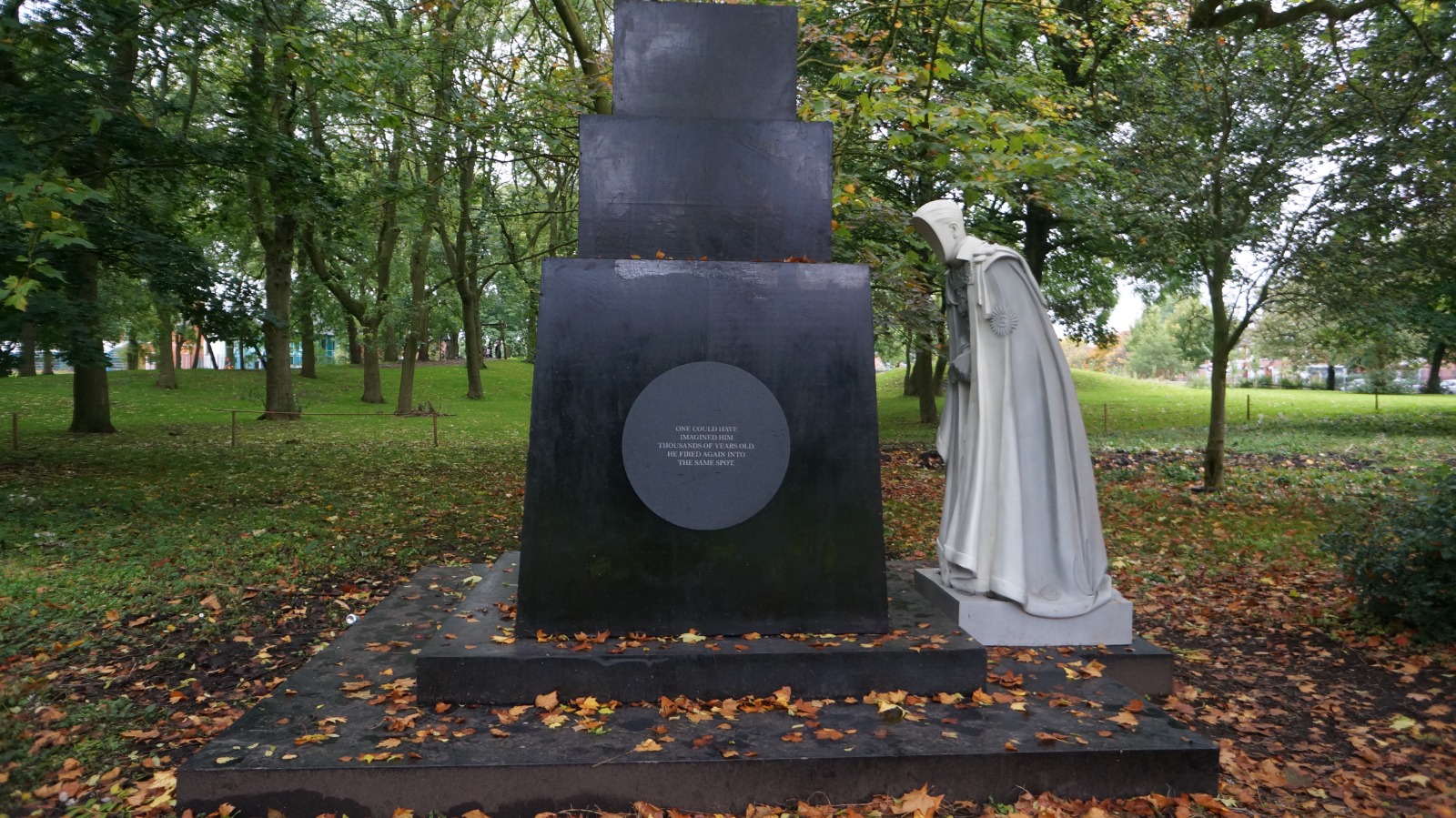
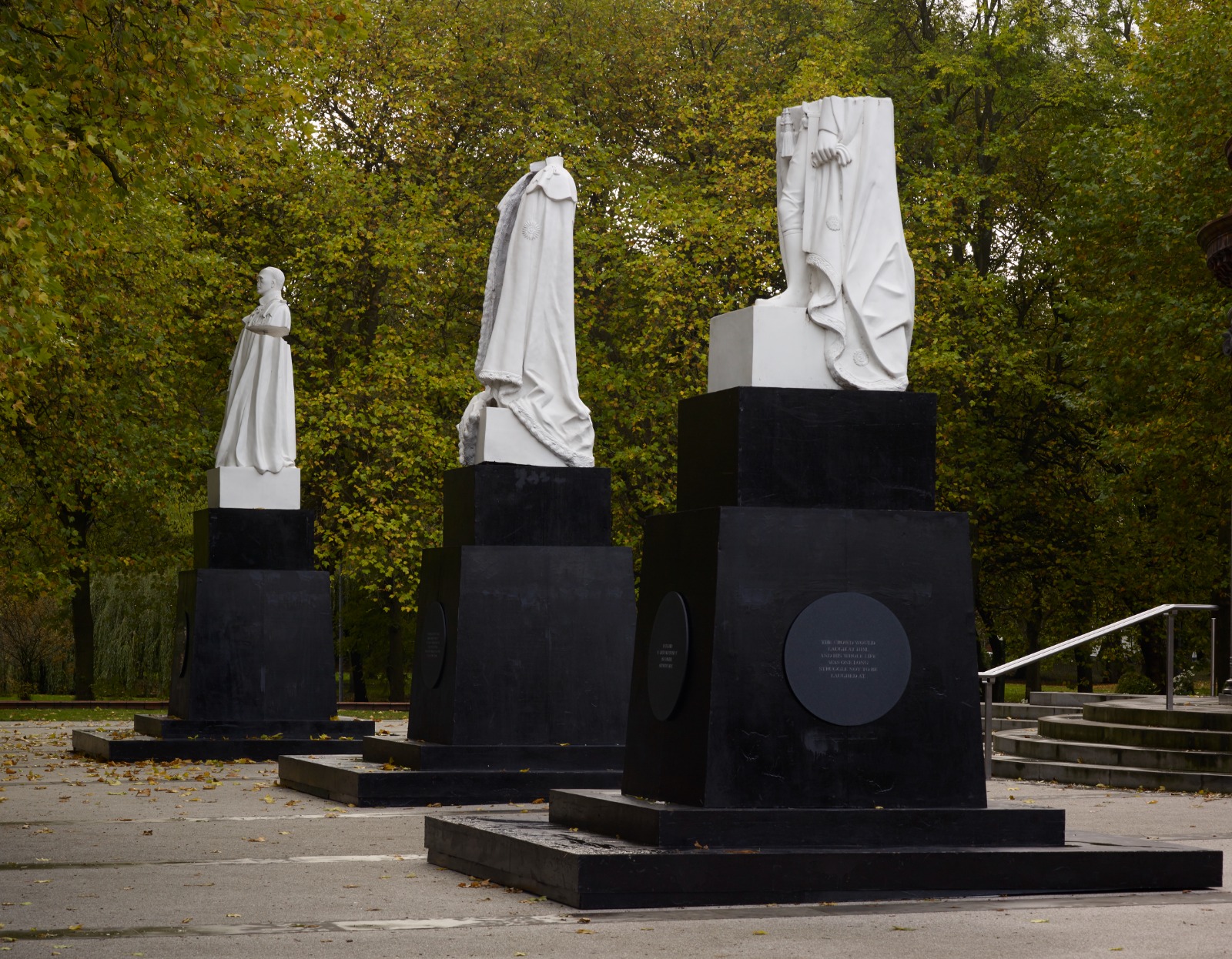
Steel, matt automotive paint, text, electrics
55.9 x 203.2 x 15.2 cm
While retrieving the time gained in searching for all that is lost and found one can admit to a condition that one suspects that one shares with most people in the world today, of being lost, in search of time.
Iteration at: K21, Museum for 21st Century Art, Dusseldorf (2018)
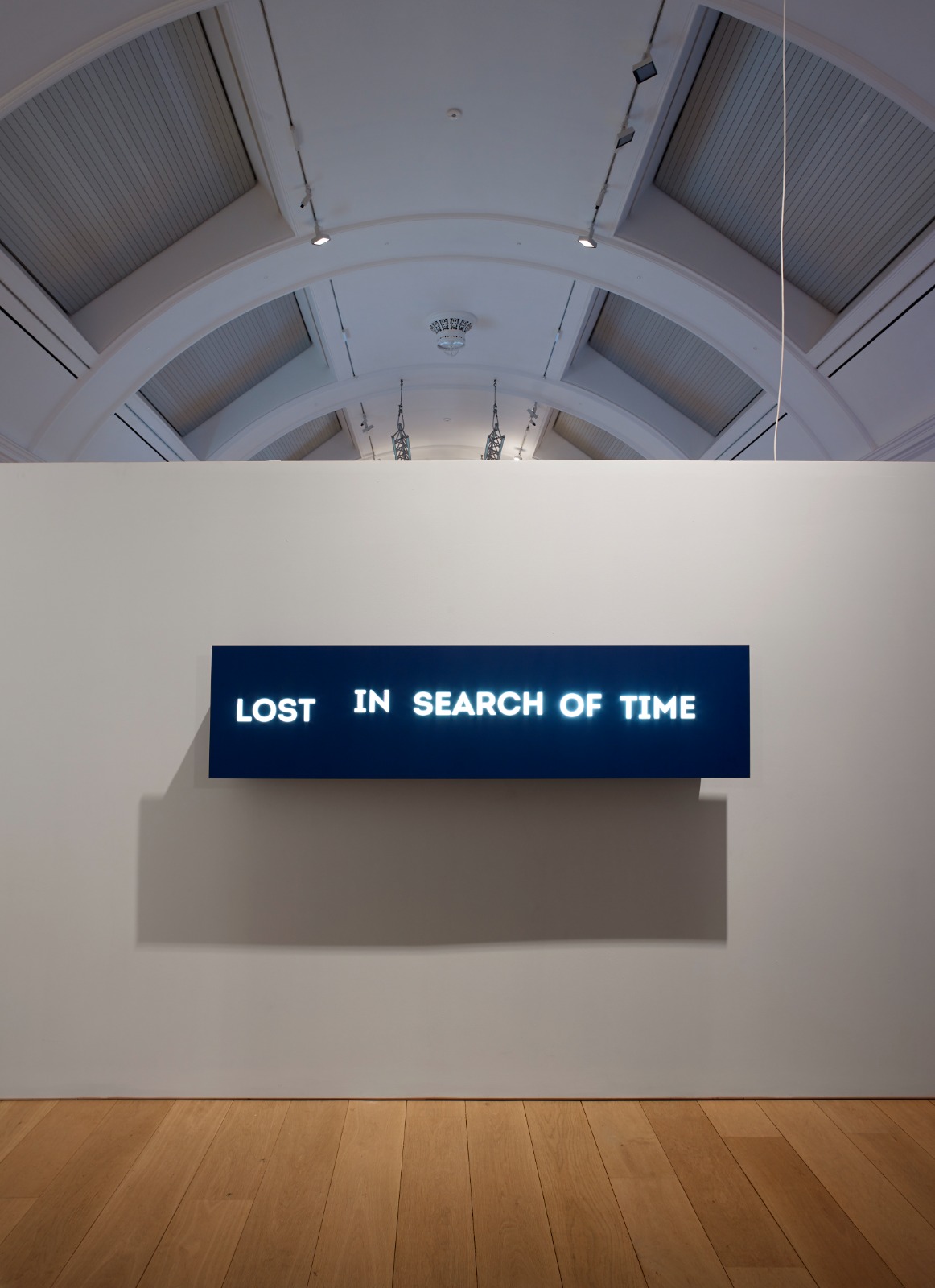
Video Loop
Duration, 7’48”
Henri Cartier-Bresson took a photograph of a bank run in Shanghai in December 1948: A crowd of people desperate to get their money out of a bank in anticipation of an imminent collapse of the value of money in the lead up to the take-over of Shanghai by the People’s Liberation Army.
Every bank-run is propelled on the currents of a self-fulfilling prophecy: As people lose confidence in the value of money, they begin withdrawing money from banks which leads to a collapse of a bank’s worth; panic spreads between banks. And so, cause becomes effect becomes cause. The anticipation of the future produces conditions in the present that lead to the anticipated future. Time folds in on itself like a snake biting its own tail.
In revisiting and re-staging Cartier Bresson’s photograph in Shanghai, Raqs meet the conditions of the self-fulfilling prophecy invoked by the event captured in the original image. Cartier-Bresson’s decisive moment breaks its banks and seeks the custody of other hands. Mid-wived by other eyes and cameras, the image reincarnates as its own breathing and vivid clone, close to where we are today. The memory of one moment of crisis is transposed onto the reading of another. Time folds in on itself, again.
Iterations at: Chronus Art Center, Shanghai (2013) | NGMA, New Delhi (2014) |K21, Museum for 21st Century Art, Dusseldorf (2018)
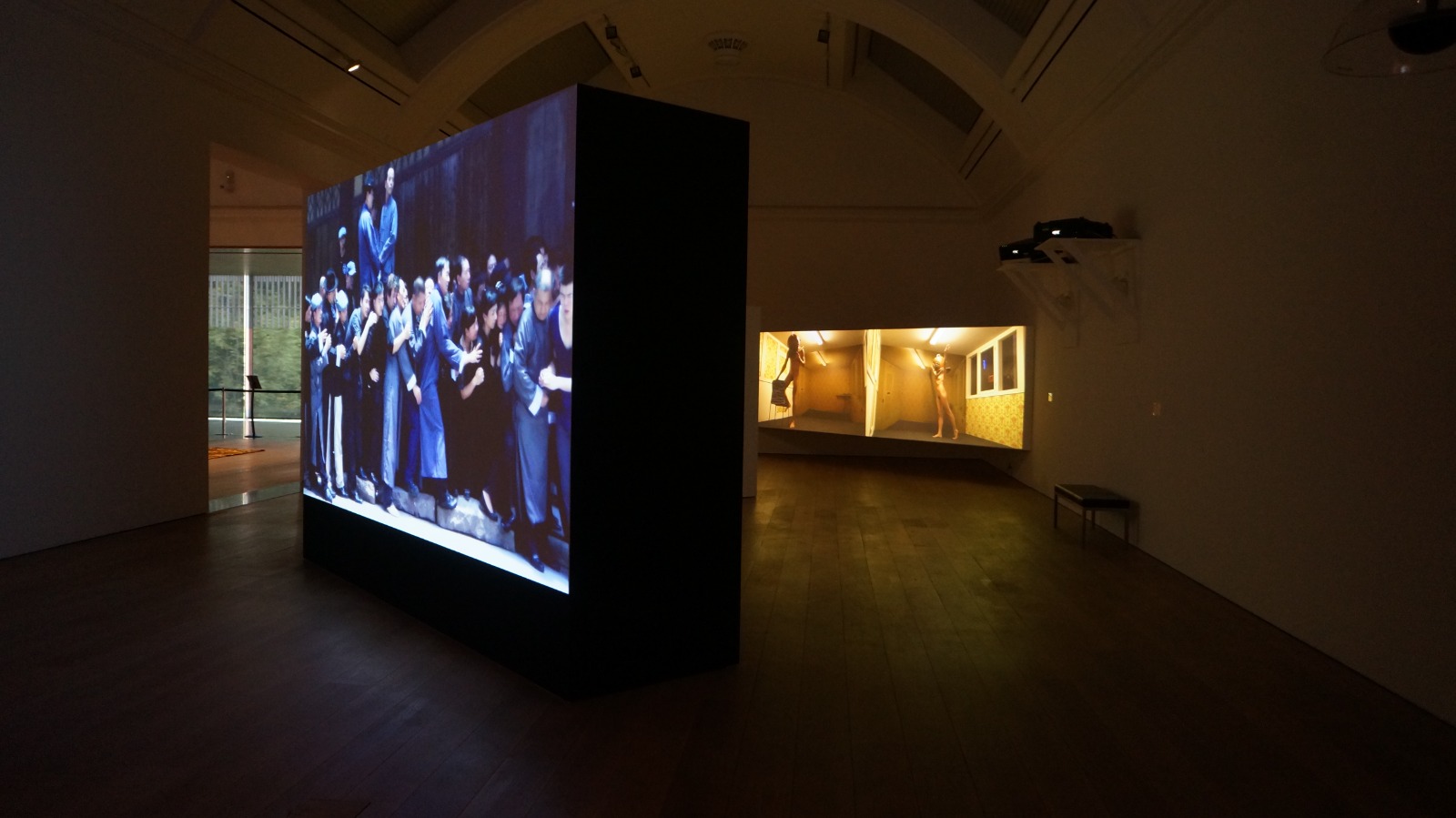
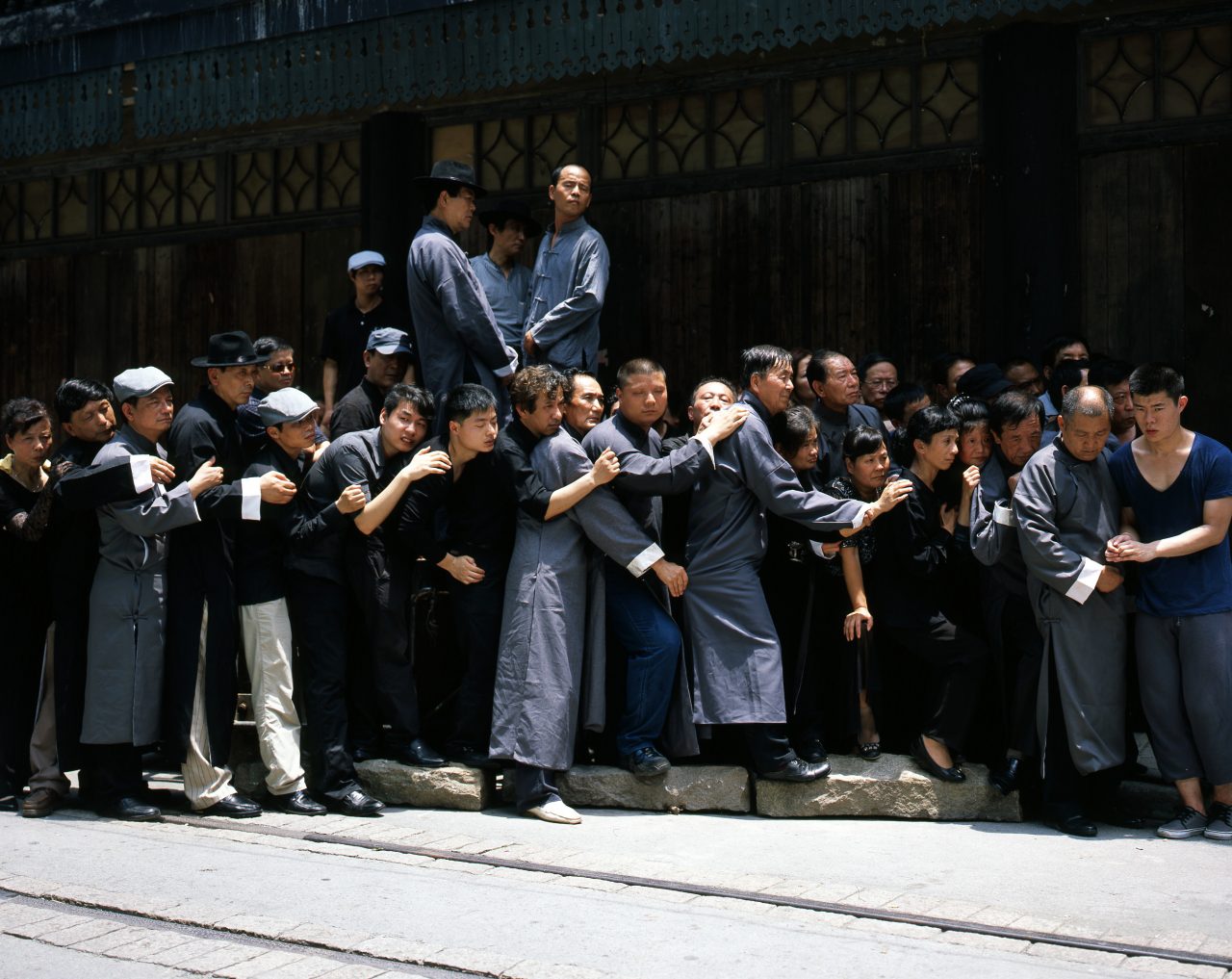
Prostheses for the History of Insurgent Crowds
Printed panels with wax ex-voto limbs, wallpaper
24 panels, each 1 x 1m
The acceleration of the assembly line is interrupted by accidents. Legs, arms, hands, eyes, and other bits of life become unpredictable crowds (found ex-votos from a Mumbai church) at the altars of progress and speed. Bodies assemble behind the limbs – pixelated human forms – to constitute a counter-collective. Who breaks whom? What is broken and what is healed?
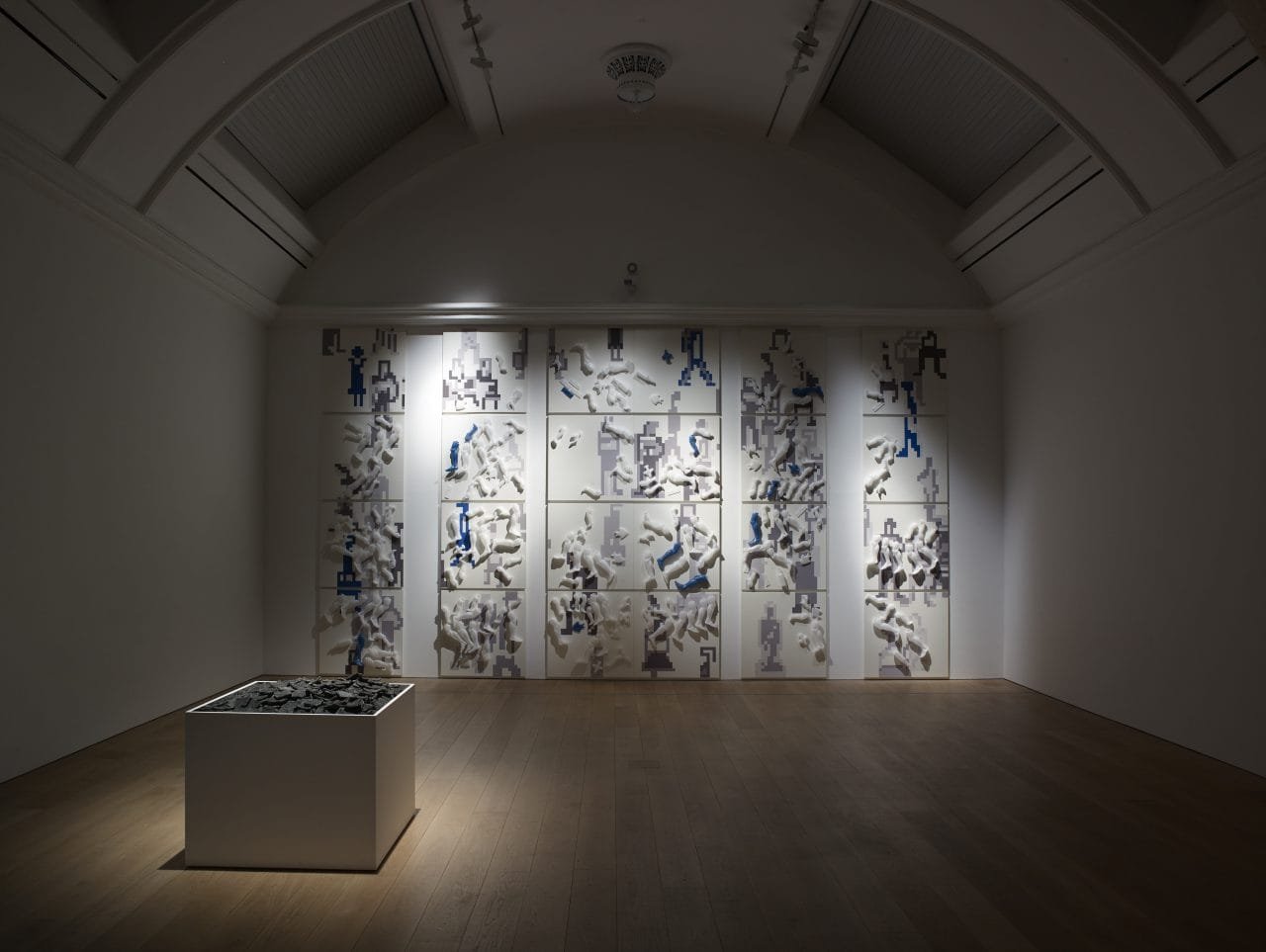
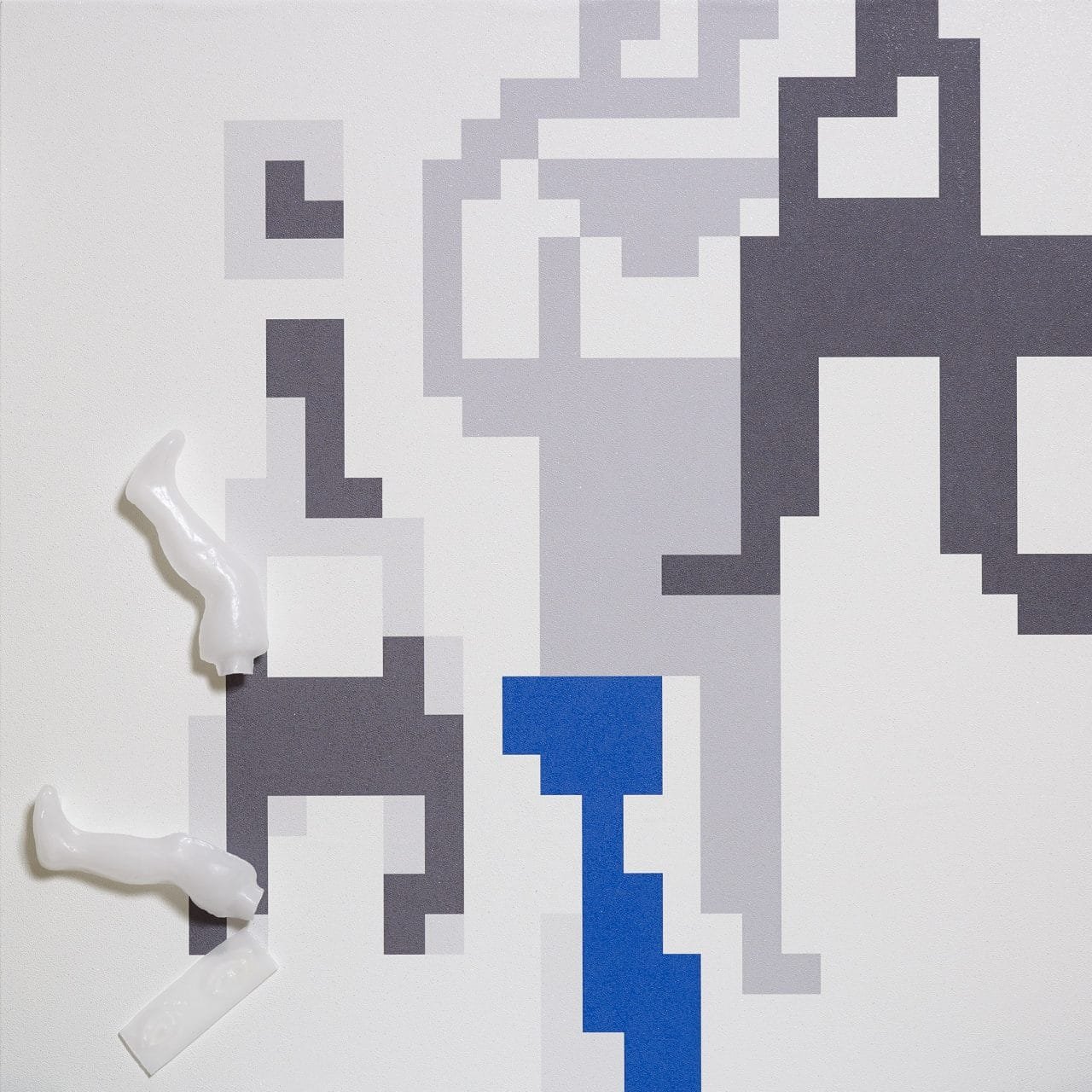
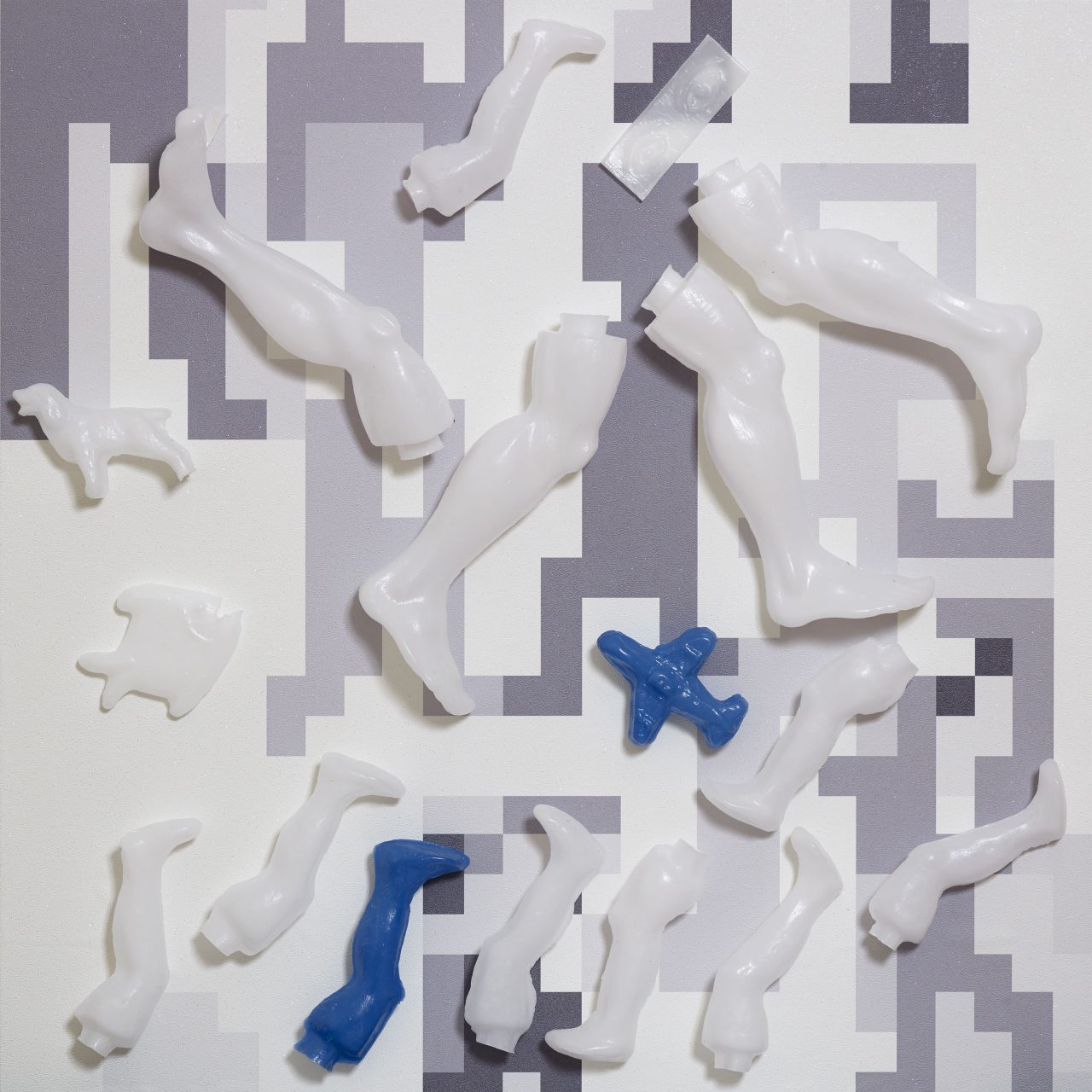
Wool carpet with metalicised thread embroidery, tone generators, electrics
4.8 x 4m
The Necessity of Eternity recounts what must be one of the most exciting yet neglected exchanges (Al-As’Ilah Wa’L-Ajwibah/Questions and Answers) in the intellectual history of the world.
In the year 999 (CE), a twenty eight year old Al Beruni, sitting by the shores of the Aral Sea in Gurganj (in present day Turkmenistan) wrote a letter to the eighteen year old Ibn Sina, two hundred and fifty miles away in Bukhara (in Uzbekistan today) that inaugurated an exchange that lasted for two years.
What were Al Beruni and Ibn Sina quarreling about? Their disagreements centred around divergent readings of Aristotle’s understanding of heaven and the stars. “Are there other solar systems among the stars”, Al Biruni and Ibn Sina asked, “or are we alone in the universe?”
Ibn Sina answered Al Biruni’s challenges by asserting that the consideration of infinity necessarily entailed the admissibility of many worlds other than our own. The possibility of many worlds was simply a corollary of the necessity of infinity.
Six hundred years later, Giordano Bruno would be burned at the stake for championing the plurality of words…but to these two men it seemed clear that we are not alone; unique, probable, but not alone.
Raqs turn to this exchange to perform a polemic that foregrounds plenitude, doubt and the need to set foot on other worlds. By speculating the future of evolution of the human species and the possibility of exploring other worlds, they gesture to the presence of infinity in our lives. In doing this, they inherit the past and reclaim the future.
Iteration at: ‘Tamawuj’, Sharjah Biennale 13, Sharjah
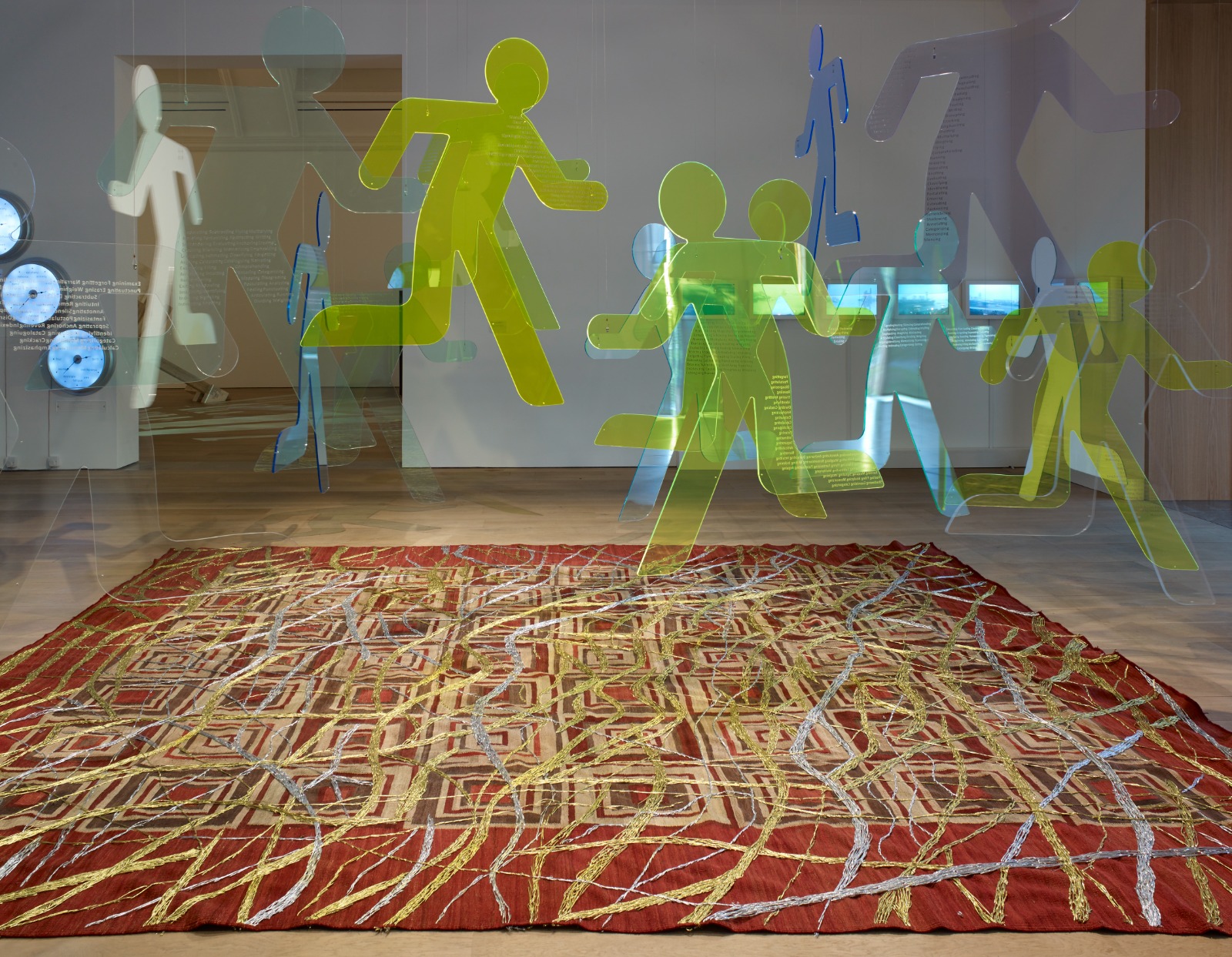
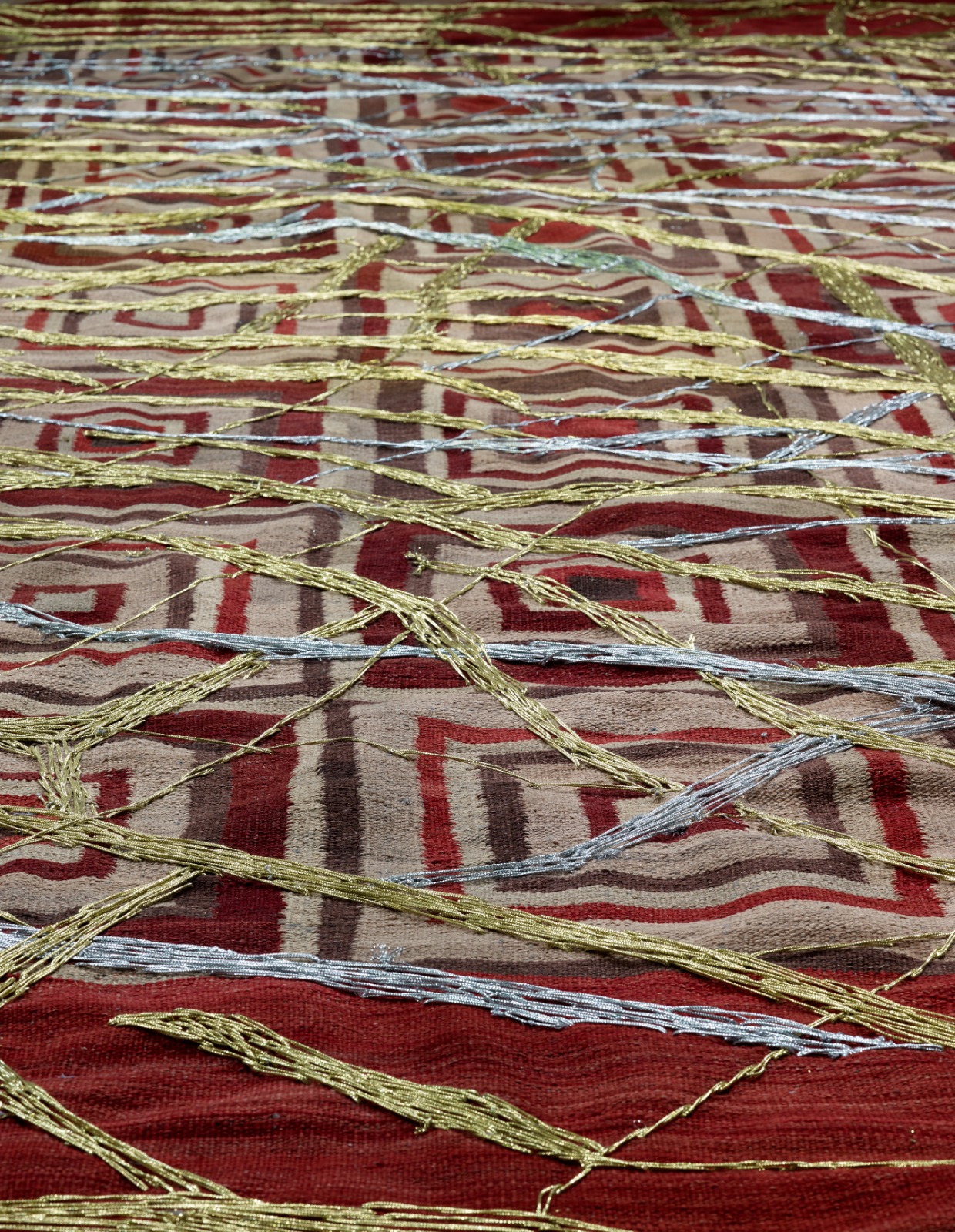
Divers at Work
Synchronised video dipytch, wallpaper
Duration 6′
The missing fourth wall of a room saves it from claustrophobia. The walls, and slightly low ceiling, are papered over by prints that create the illusion of the room folding in on itself, as well as multiplying. So that the surface of one room seems to hold the secret of another. The nearly replicant room within the room suggested by wall-paper is just short of being identical to itself. Odd things are askew, or not quite what they seem to be, like pieces in a ‘spot the difference’ puzzle image.
The rooms are as alike, or as apart, as investment and insurance, two mechanisms designed to administer, anticipate and forestall, risk, speculation and the possibility of boom and bust. Does the imprint of one room on another indicate caution or audacity? This is a space of ambivalence, caution only emphasizes the latency of risk. Everything is anticipated, yet anything is possible.
An iteration of the work Activo y Passivo (2014)
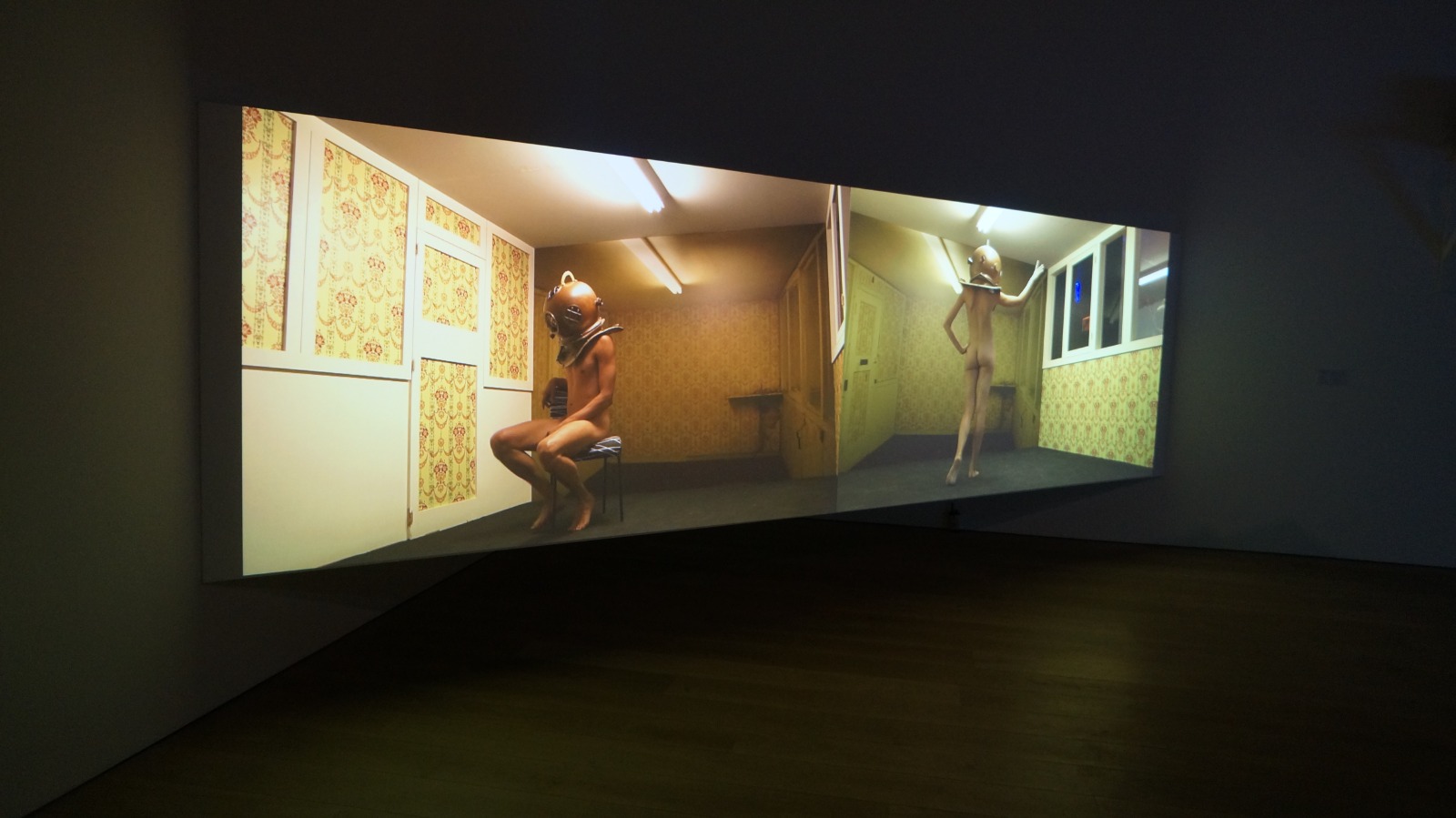
Alive, with Cerussite and Peppered Moth
3D printed PLA plastic, cast polyester resin, plywood and video projections Dimensions variable
Architectural Collaborators: Palak Jhunjhunwala and Stratis Georgiu
This architectural installation speaks to the evolution of materials and living forms across alternative time epochs. The 3D printed structure represents crystal cerussite ,while the light projections refer to the changing colorations of the peppered moth that occurred during the industrial revolution. At the beginning of the age, the black and white peppered moth experienced industrial melanism – its pigment became black for better camouflage in an environment polluted with soot residues. This evolutionary strategy was reversed when pollution levels were reduced. These varied states of transformation speak to changing invisible threads of ecology, and compressed time.
The work is now in the permanent collection of Mathaf Arab Museum of Modern Art , Doha.
Iterations at: Mathaf Arab Museum of Modern Art , Doha (2019) | Palais de Tokyo, Paris (2020)
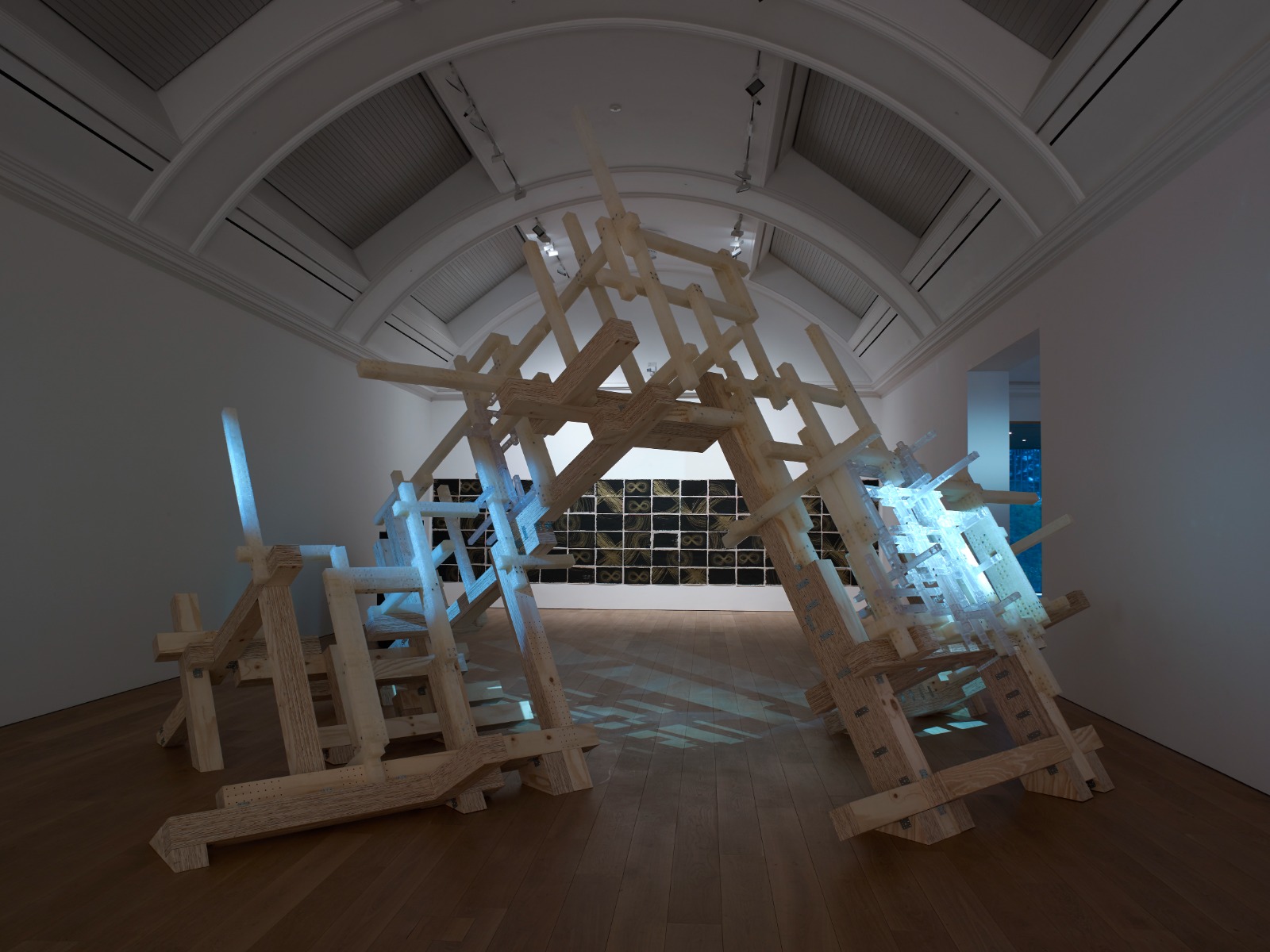
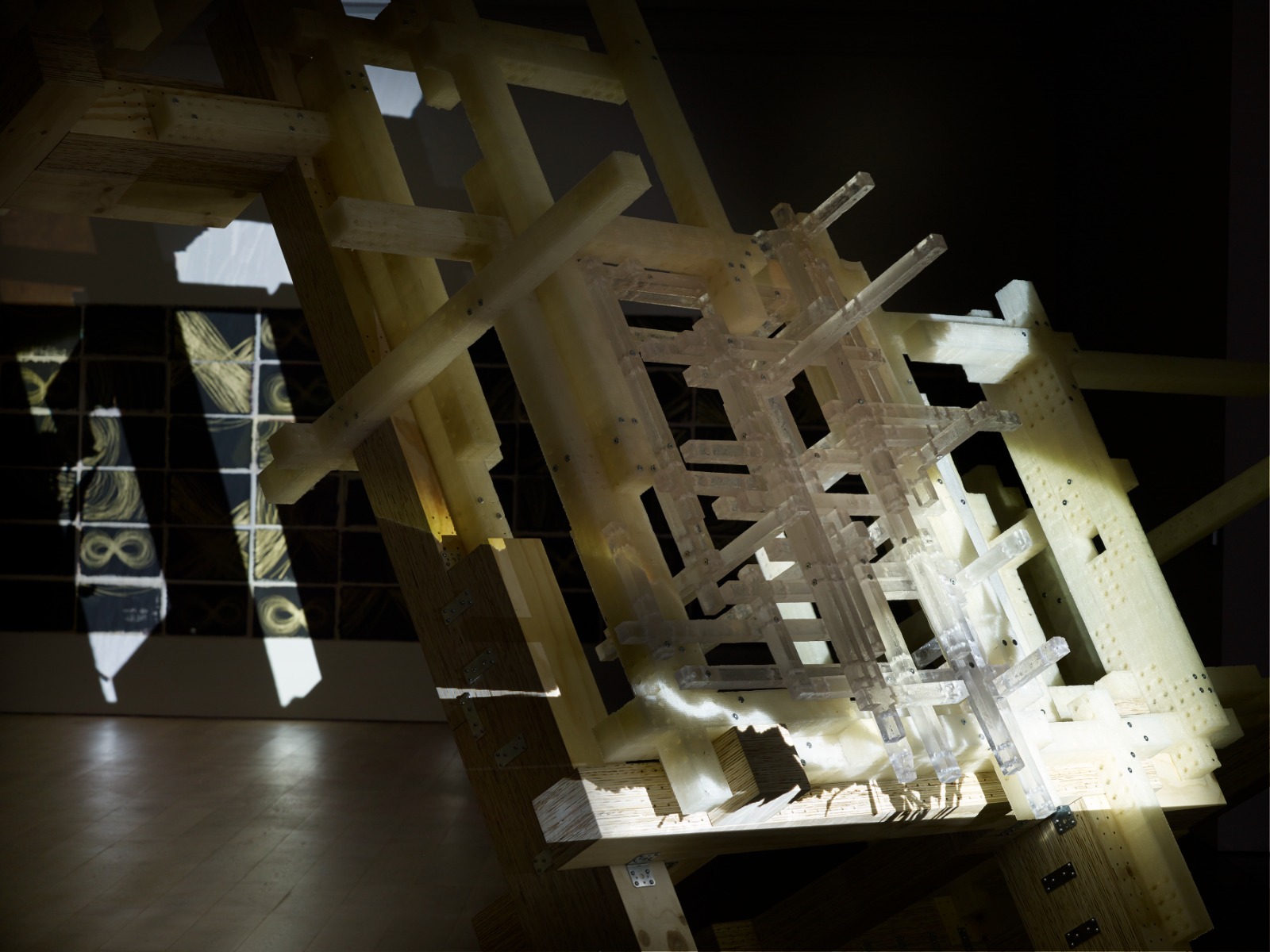
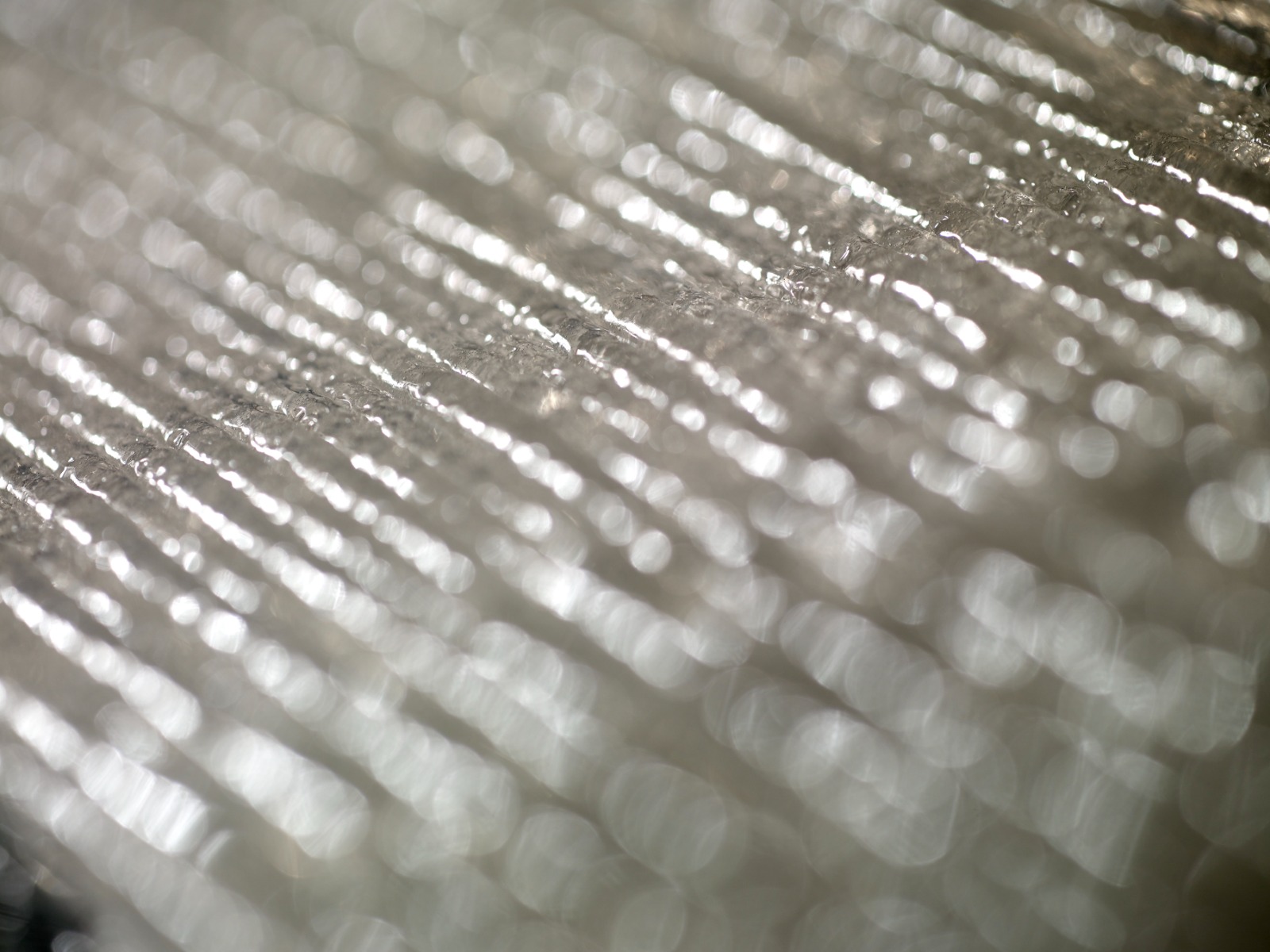
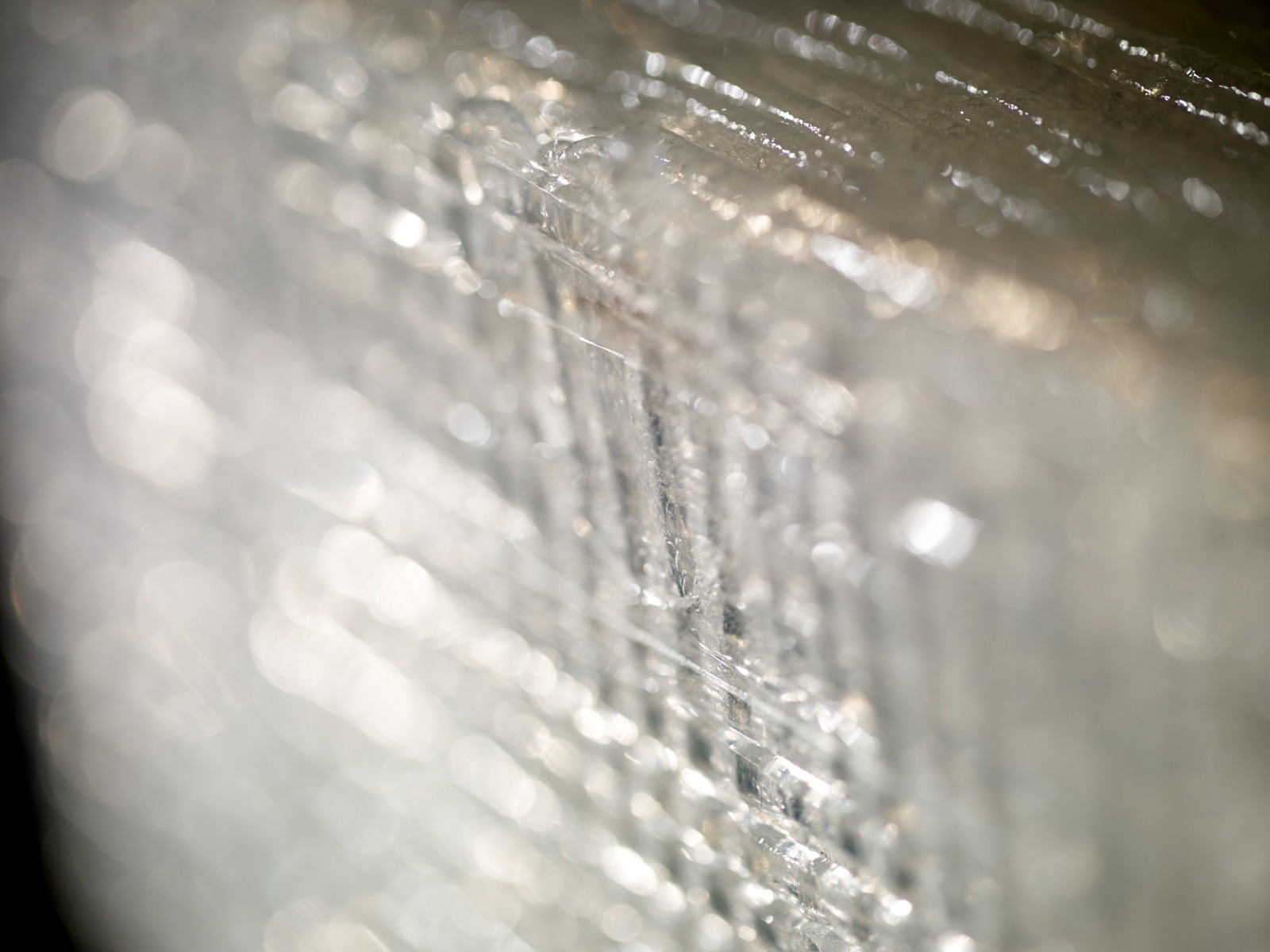
Meerut Redux (2017)
Reading Performance on the steps of the Whitworth Gallery by people of Manchester
Courtesy of the Working Class Movement Library, Salford
Meerut Redux is a reprised reading, in a contemporary interpretation, of ‘Meerut’, a 1930s agit-prop sketch against the imprisonment of workers and activists under the Meerut Conspiracy Case in India. ‘Meerut’ was performed in Manchester and across the North West in the 1930s in solidarity with the Meerut Conspiracy Case detainees by the Red Megaphones, a left-wing theatre group. The manuscript of ‘Meerut’ was made available for reading courtesy of the Working Class Movement Library, Salford, where it was found by Raqs Media Collective during their research trip to Manchester in 2016.
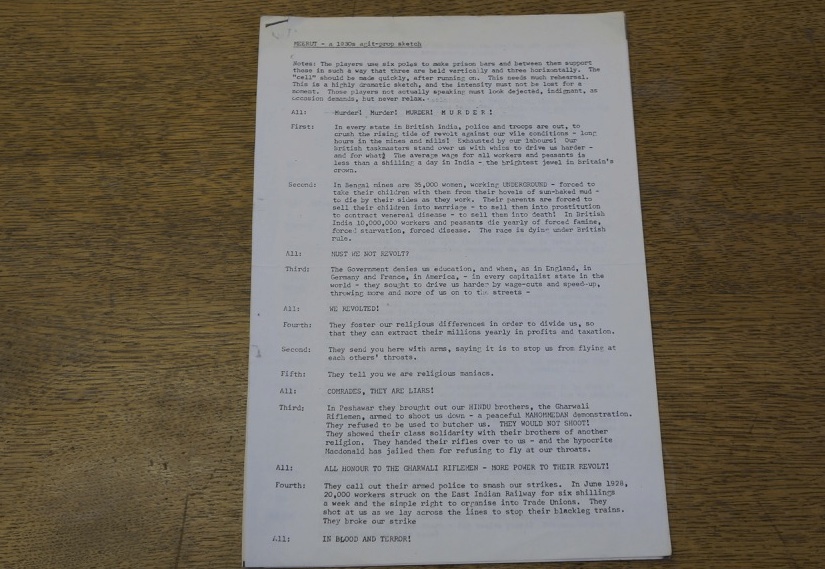
The Mnemonist Quartet (2017)
Four videos, shown vertically on flat TV monitors
Duration 2’30”
Portraits, neither still, nor moving, of four urban mnemonists, custodians of Manchester’s memory – a keeper of minerals at the Manchester Museum (David Gelsthorpe), a custodian of the history of the suffragette agitation and the feminist movement at Emmeline Pankhurst’s house (Gail Heath), the Librarian of Chatham’s Library, where Karl Marx and Friedrich Engels met to undertake their studies of political economy (Michael Powell) and the late walking historian of Manchester’s streets and alleys (Ed Gilbert)
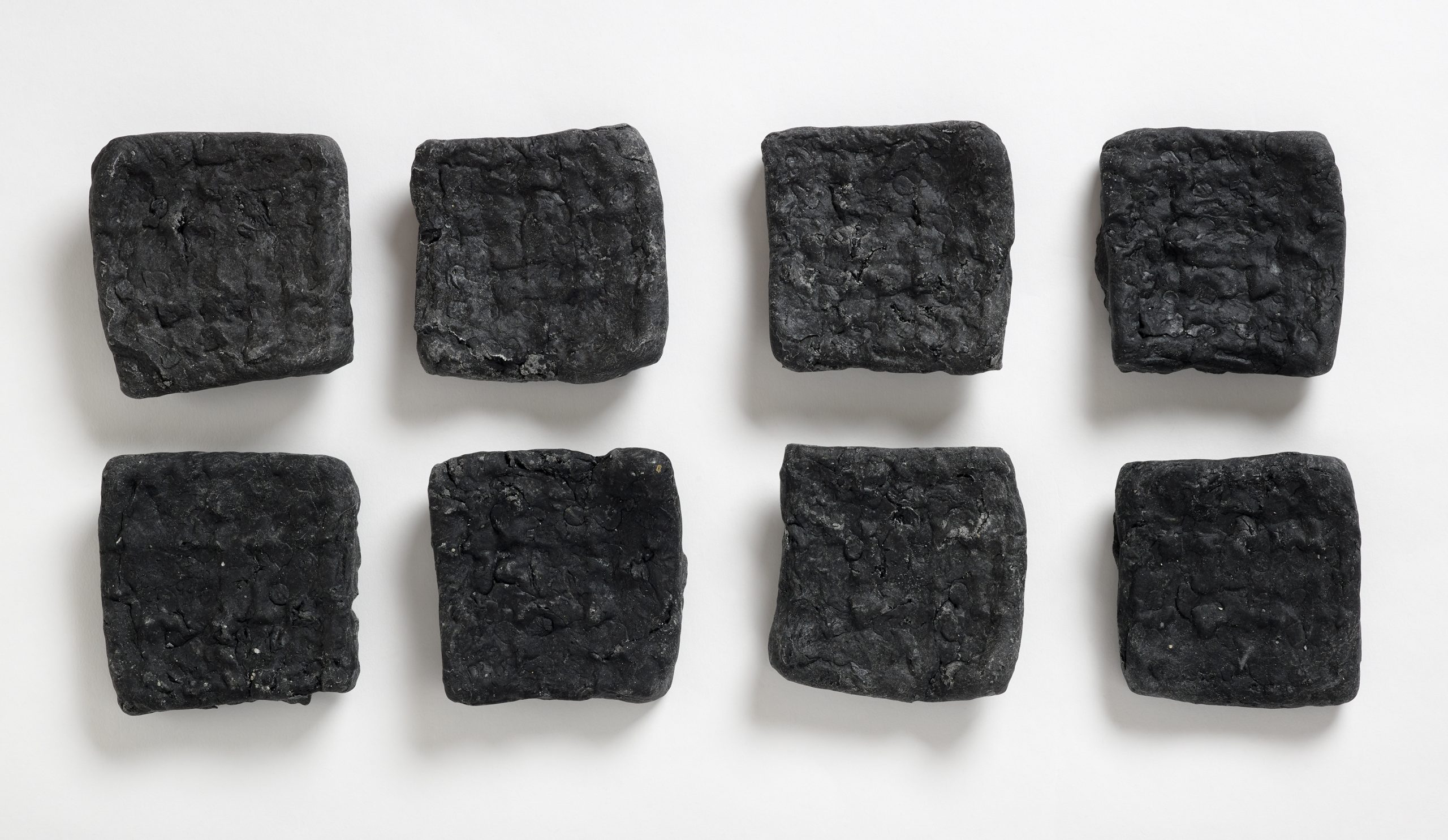
3 D Printing, Silicone mould, flour, water, salt
500 biscuits, 9 x 1 x 1 cm (each)
A hard tack biscuit from the Paris Commune of 1871 was 3D scanned, 3D printed, a mould made and facsimile biscuits baked. History in facsimile, waiting for a bite.
Made in collaboration with the People’s History Museum, Kathryn Downey, University of Manchester and the Modern Caterer .
